Given that I’m a professional translator by trade (including simultaneous interpreting) and operate as a freelance artist, meaning I don’t work for anyone permanently, but rather on an as-needed basis, it so happens that over the past couple of decades, I’ve had numerous opportunities to work in a building formerly known as the SIV Building, now called the Palace of Serbia. It’s located in Novi Beograd, a part of Belgrade, the Serbian capital.
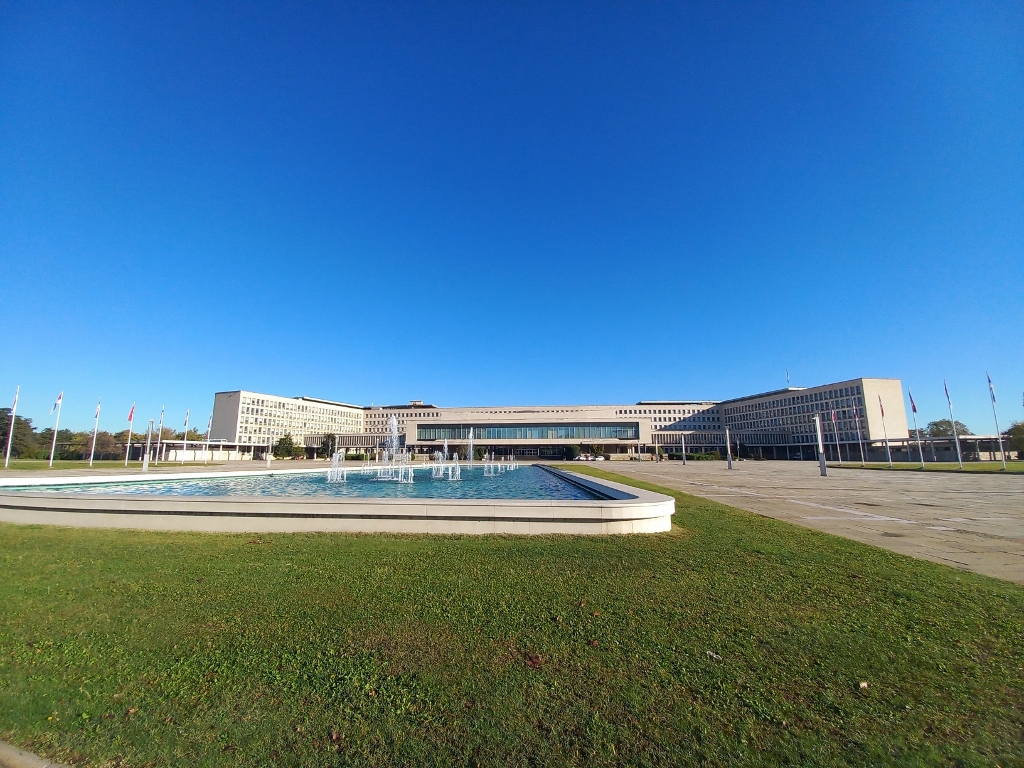 Palace of Serbia
Palace of Serbia
For those unfamiliar with this building, let me clarify that SIV stands for “Savezno izvršno veće” (Federal Executive Council), which essentially was the name for the government of the SFRY, i.e., the Socialist Federal Republic of Yugoslavia (aka, ex-Yugoslavia).
After the dissolution of the former state, when Serbia became a state in its own right, and when I occasionally began working in this building, the situation was highly uncertain. Namely, the country for whose government this enormous building was constructed (62,000 sq. m, including 744 office spaces) had significantly diminished and its successor found itself in a considerable financial crisis in the early 21st century, after years of economic sanctions, wars and NATO bombing of 1999.
When I say the situation was uncertain, I must clarify that it was my personal perception. The building, at least the part I frequented, often felt like a ghost town – vast spaces with nobody around. I also recall that during lunches organised for participants of the events where I translated, utensils with the emblem of the SFRY were still used, even though the country no longer existed, perhaps because there wasn’t enough money to purchase new ones and the old ones still served their purpose perfectly well. The utensil situation was actually so interesting that on one occasion, a foreign guest remarked during lunch that he simply had to take a fork as a souvenir because it was an absolute rarity and it seemed like a good joke. I don’t think anyone missed that fork.
During that time, I often looked around at the entire vast space, seemingly unused, and pondered what could be done with such a building that would make sense. Additionally, the interpreter rooms adjacent to one large hall were built according to some old standards, so I remember that during the first few years, they were unbearably hot and stuffy, which was extremely uncomfortable and made work even more difficult.
It seemed like there was no money for maintenance, let alone any kind of improvement, so I wondered if perhaps a museum could be housed here, but, apart from the impressive central part, the building also has two wings on multiple floors filled with offices. That wouldn’t serve any purpose within my envisioned museum.
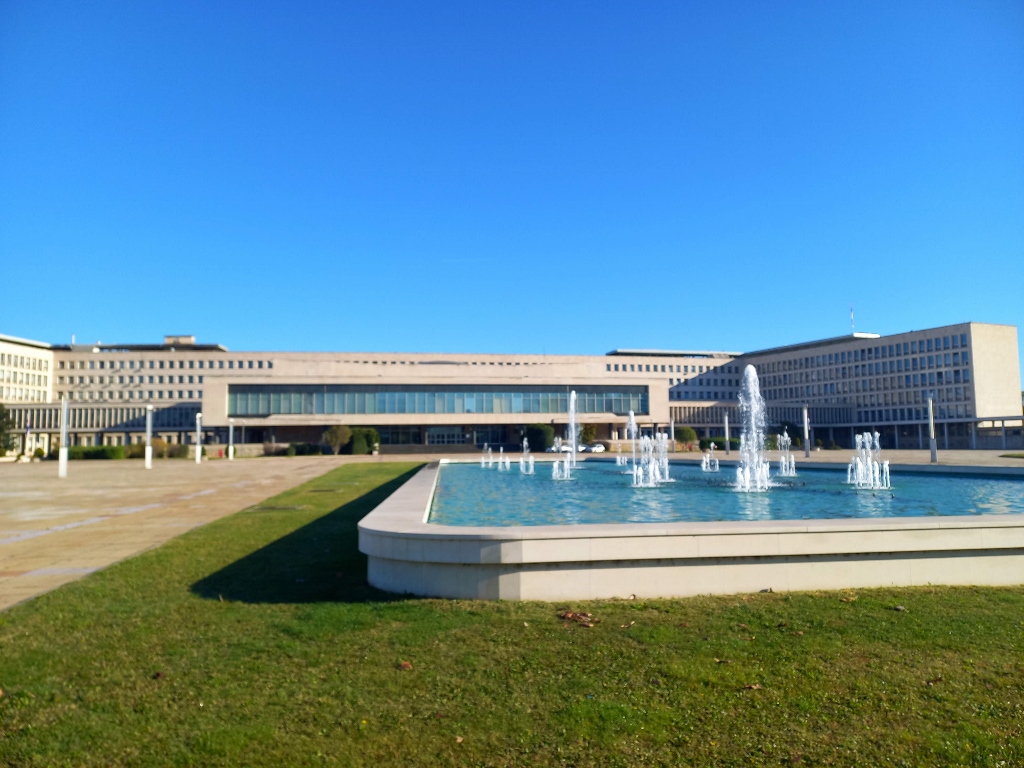 Palace of Serbia
Palace of Serbia
The times gradually started to change and, luckily, nobody asked me for my opinion. The impression of the “ghost town” slowly faded away and although people working here during the day undoubtedly do their work in their offices and don’t wander aimlessly around the building, so you still don’t encounter many of them in the hallways, the energy of the place began to shift and I could see and feel that the building was increasingly functioning according to its original vision.
Furthermore, things started to change slowly also regarding the engagement of interpreters like myself. In a sort of a “transitional period,” a literal hole was punched in one part of the wall behind those interpreter booths I have mentioned, allowing some fresh air to come through from somewhere, but at least one could breathe. However, today, everything is very well arranged, renovated, the booths have been expanded and connected to the central system for heating and cooling, so now one can breathe easily and work comfortably.
And even the utensils have changed, with not even a fork or a spoon left from the former state.
I'm sharing all of this because in the autumn of 2023, I was once again engaged in some work at the Palace of Serbia and then it happened that a guided tour of the building was organised for the participants of that event, so my colleague and friend Beka and I were able to join them. This also served as inspiration for this “travelogue” about Novi Beograd.
However, before I start writing and illustrating that tour of the Palace of Serbia, specifically its central representative part, let me say a few words about the building itself, which is categorised as a cultural monument.
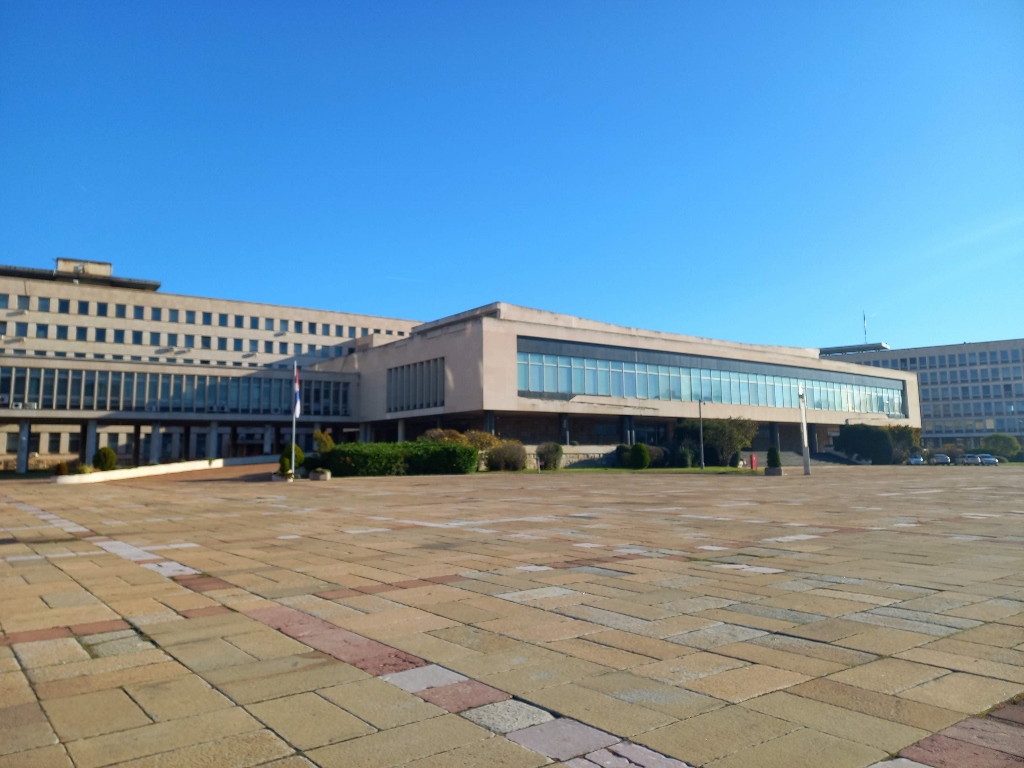 Palace of Serbia
Palace of Serbia
The building was constructed between 1947 and 1961, and was officially opened for the First Summit of the Non-Aligned Movement, which was held in Belgrade, in the then Yugoslavia. One of the founders of this movement was Yugoslav President Josip Broz Tito (1892-1980) and alongside him, the leaders of this movement included Indian Prime Minister Jawaharlal Nehru (1889-1964) and Egyptian President Gamal Abdel Nasser (1918-1970).
Today, parts of several ministries are housed here and the building, as well as the plaza in front of it, are also used for visits of high-ranking foreign officials. In addition, the central, representative parts are used for various events, conferences, meetings, etc., dedicated to very diverse topics. I have worked as one of the interpreters at some of these events.
The original project from 1947 was modified during construction and the building eventually took on a look that reflected the modernist ideas permeating the Yugoslav architecture of that time. That’s essentially what can still be seen today.
What’s less commonly seen is the interior of the building. I should mention that it is entirely possible for interested individuals to sign up for a guided tour, but I believe one needs to contact the Tourist Organisation of Belgrade for that. Moreover, when we embarked on this “walk” with the guide, a young woman who was an architecture student joined us and, as I understood, she had apparently inquired about when she could visit the building. Then she was told that she could join this group of participants of an event taking place at the time.
I’m not sure how often or regularly the doors of this building are open to visitors, but I think it’s worth inquiring about.
The tour starts from the central hall on the upper floor.
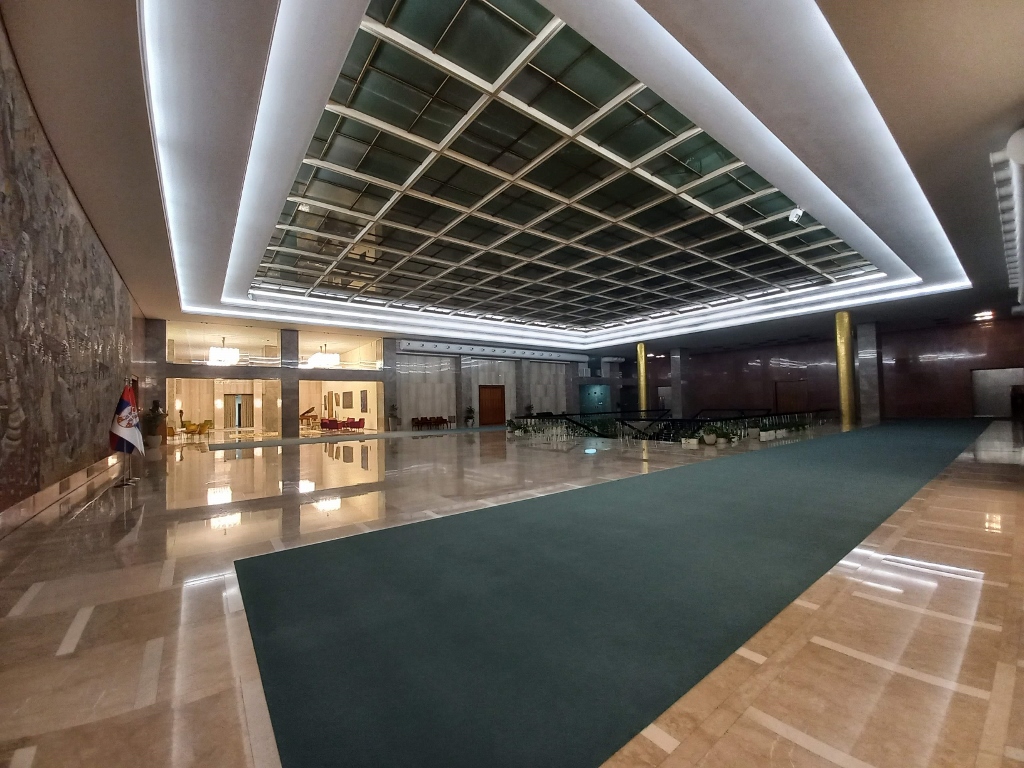 Palace of Serbia, central hall on the upper floor
Palace of Serbia, central hall on the upper floor
One of the most impressive details in the central hall is the mosaic entitled “The Sutjeska,” named after a significant battle from World War II that took place around the Sutjeska River in present-day Bosnia and Herzegovina. The mosaic, mostly made of natural stone, covers an area of 90 square meters and was created by a Slovenian artist. Namely, the interior design of the central parts of the building was overseen by a special commission, aiming not only to express the power and grandeur of the state through this edifice, but also to emphasise the unity of its peoples.
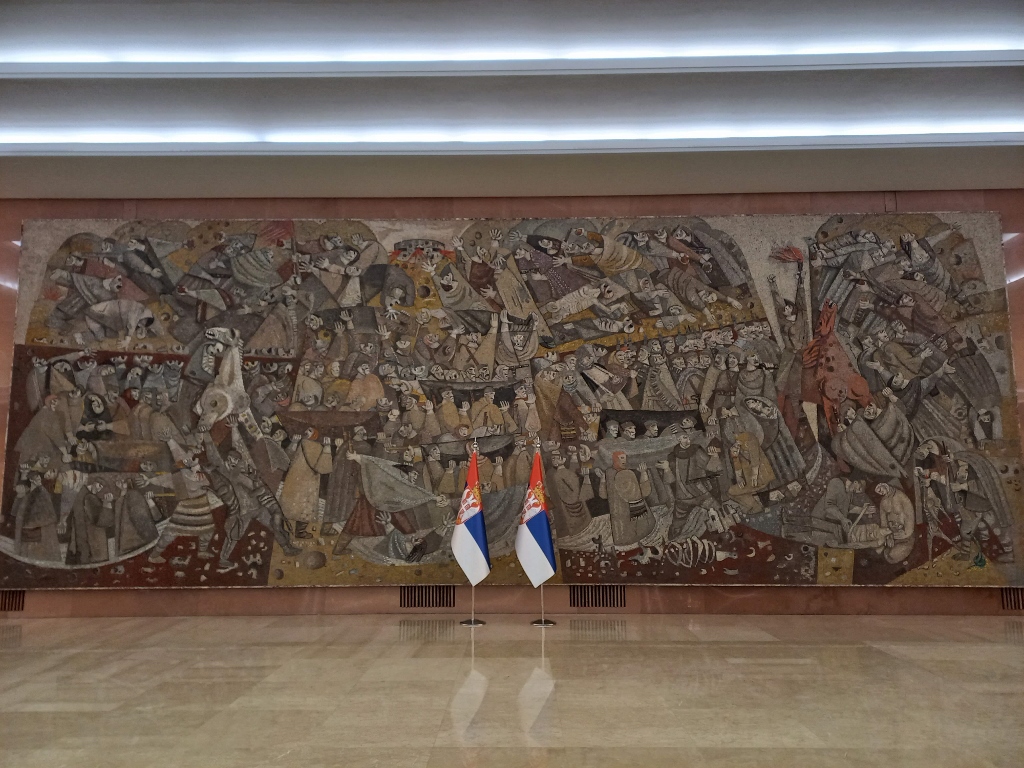 Palace of Serbia, mosaic “The Sutjeska”
Palace of Serbia, mosaic “The Sutjeska”
Directly across from this mosaic, on the other side of the large staircase leading from the ground floor to the upper floor, there are large closed doors. As we were told, this was Tito’s office where he conducted his daily state duties. From there, it took him a short time to reach the ceremonial halls where he met various guests. Our tour did not include a visit to this office and I’m not sure if it’s even open to the public.
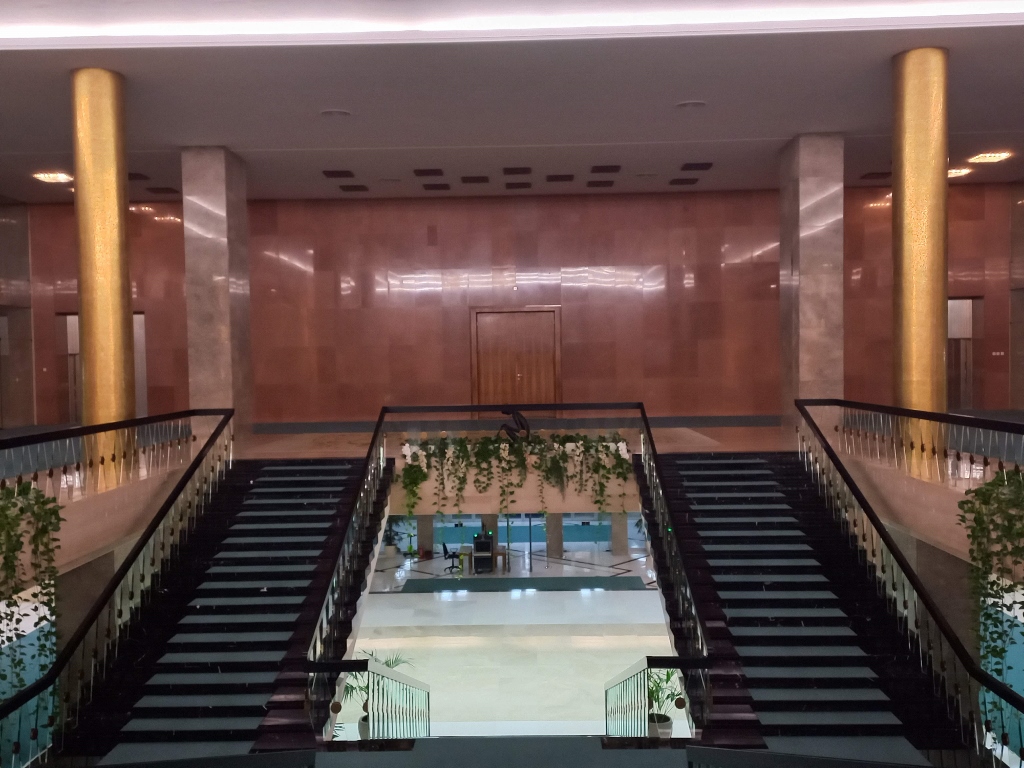 Palace of Serbia, central staircase and the door leading into Tito’s office
Palace of Serbia, central staircase and the door leading into Tito’s office
On both sides of the central hall, there are spacious foyers. The only significant difference between them is that one is the western foyer and the other is the eastern one. We first went to the West Foyer.
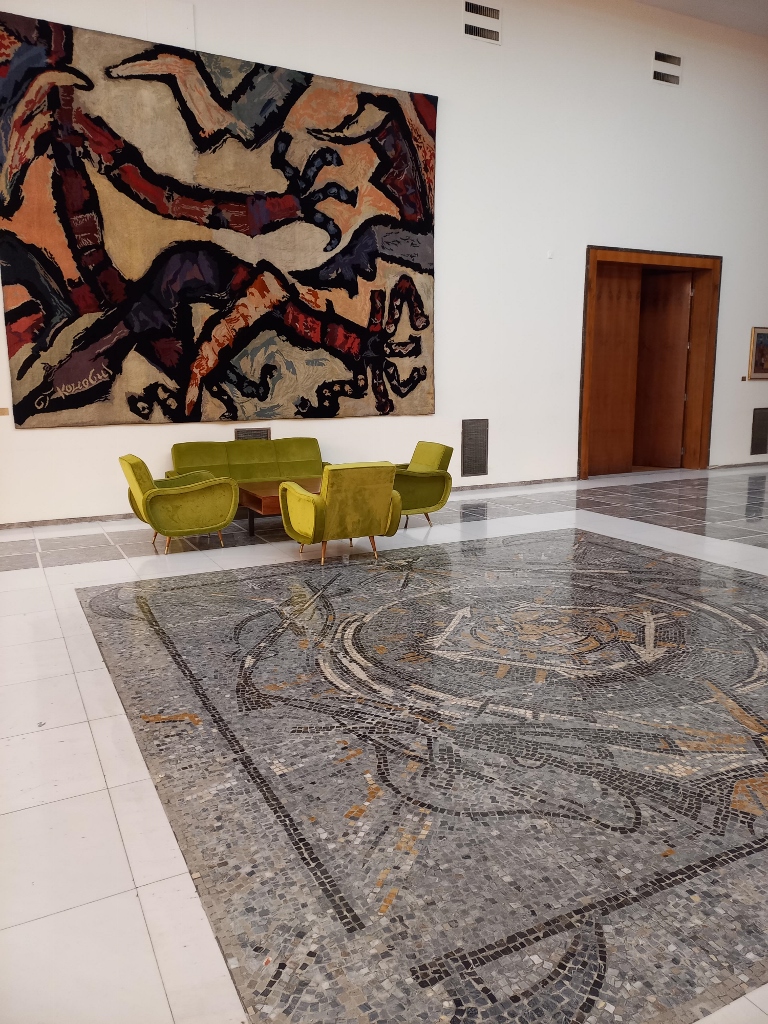 Palace of Serbia, West Foyer
Palace of Serbia, West Foyer
The interior of today’s Palace of Serbia was designed not only to reflect the strength and unity of Yugoslavia, but practically this space was transformed into a sort of gallery showcasing Yugoslav art of the 20th century. Beside each artwork, whether it’s a painting, sculpture or tapestry, you can find the title of the piece and the name of the artist. The artistic pieces also include floor mosaics and carpets.
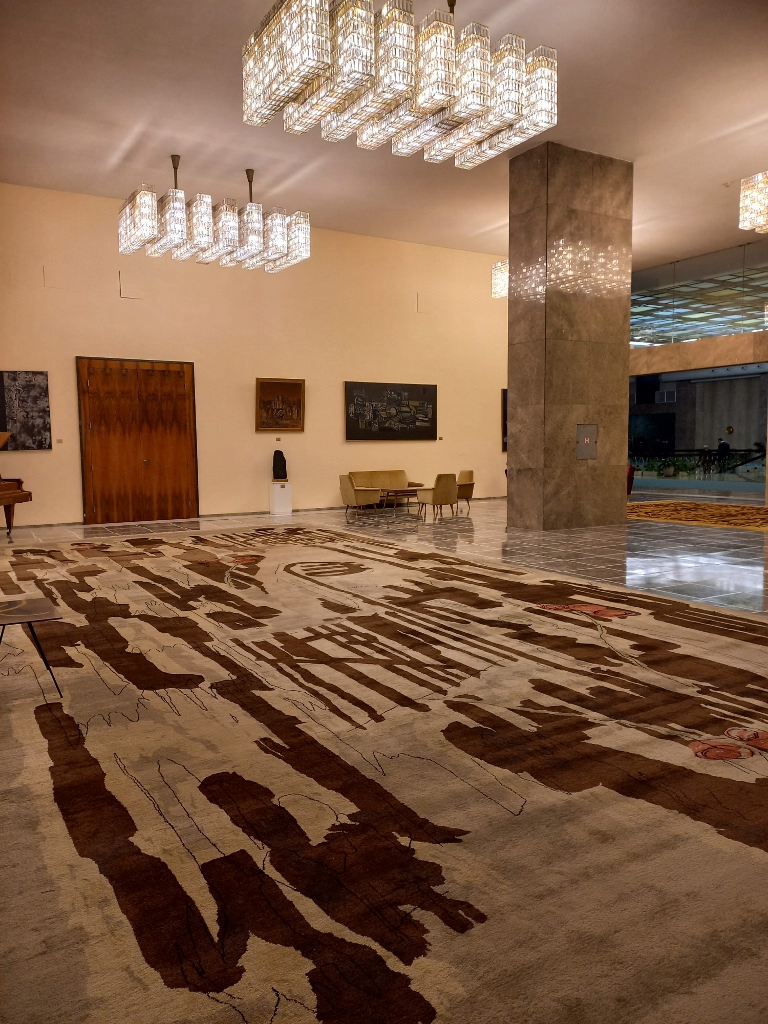 Palace of Serbia, West Foyer
Palace of Serbia, West Foyer
In addition, since the building was completed in the 1960s, the furniture reflects the fashion of that period. I must admit that I like that even the new or refurbished armchairs are done in the original style.
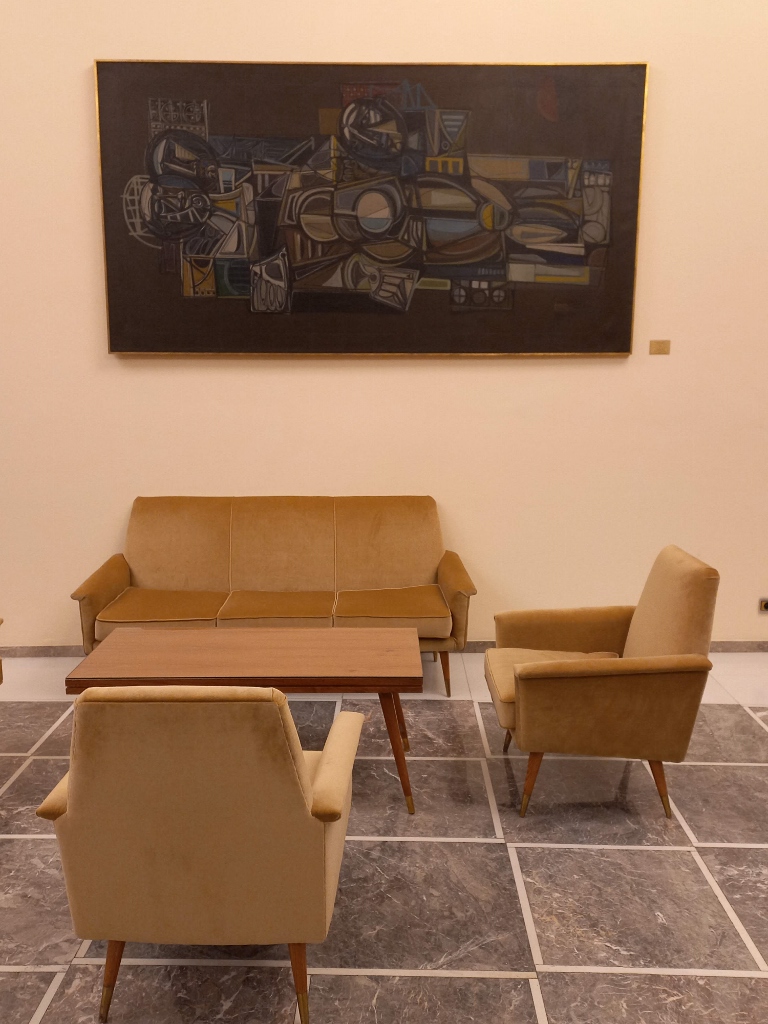 Palace of Serbia, West Foyer, a detail
Palace of Serbia, West Foyer, a detail
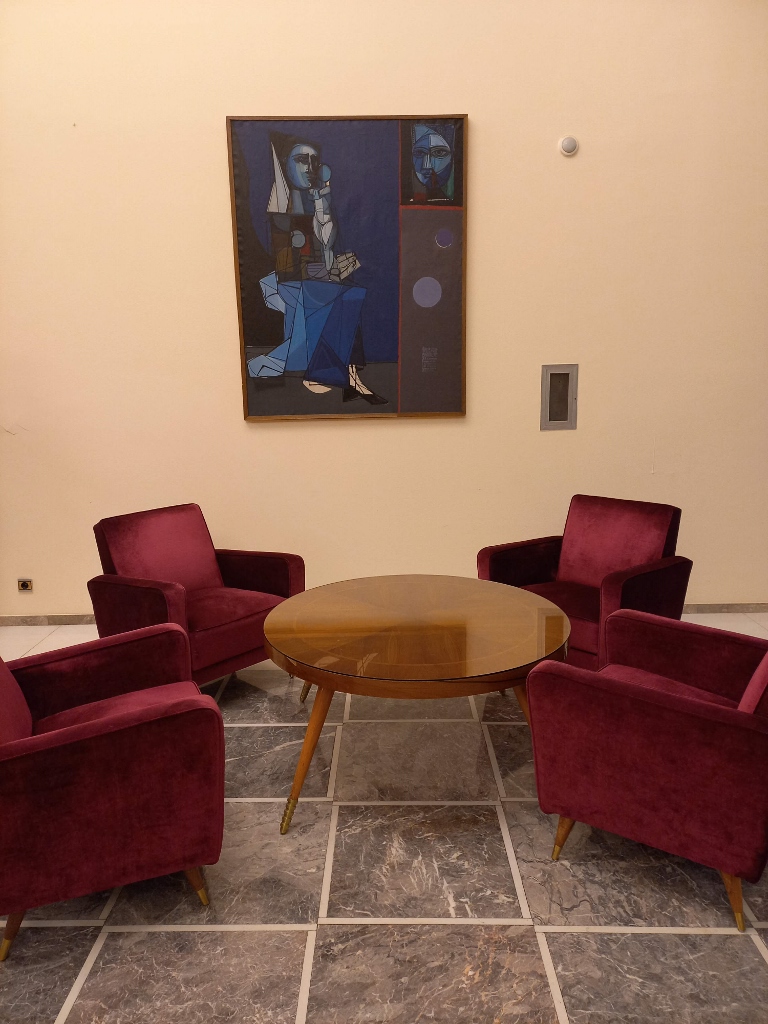 Palace of Serbia, West Foyer, a detail
Palace of Serbia, West Foyer, a detail
From the foyer, you enter salons, of which there are six, each dedicated to one of the former Yugoslav republics and that’s what they’re named after. I must admit that I really like this approach. Regardless of what happened on the territory of the former SFRY at the end of the 20th and the beginning of the 21st century, the fact is that Serbia was part of a larger entity together with the other republics. After all, the unification of these territories in the Balkans occurred after WWI, with the Serbian Karađorđević dynasty ruling the new state. Even King Alexander I Karađorđević is often referred to as the Unifier.
So, first, we entered the Macedonian Salon, named after modern-day Northern Macedonia.
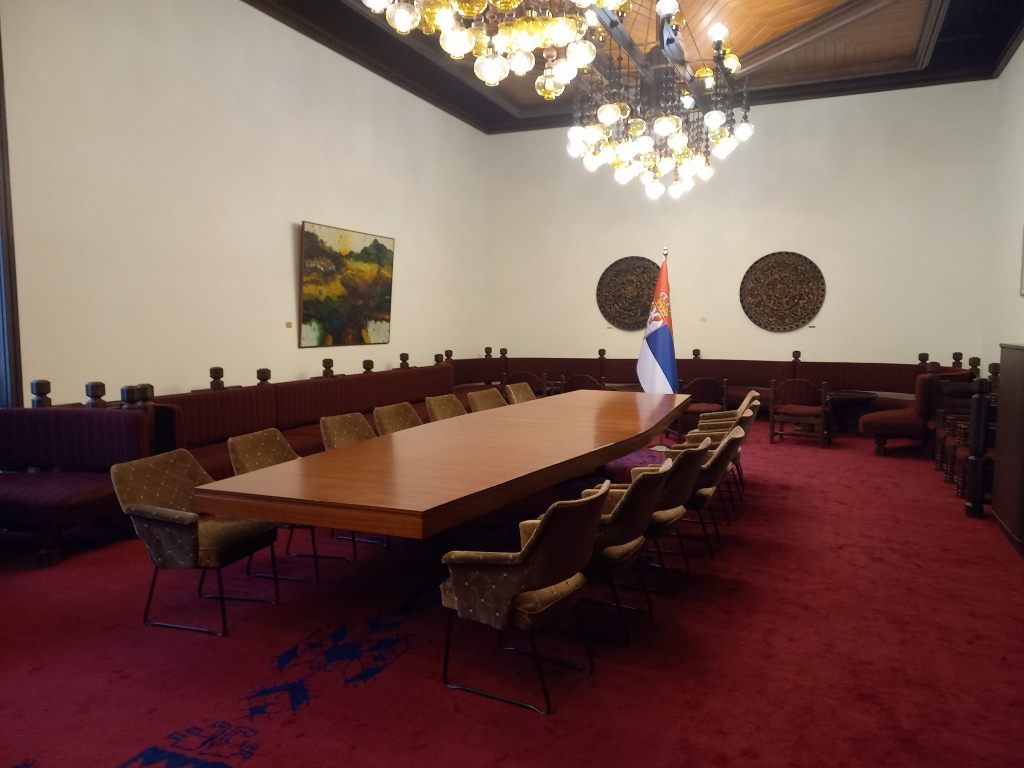 Palace of Serbia, Macedonian Salon
Palace of Serbia, Macedonian Salon
The design of this salon was entrusted to a Macedonian architect and you can see elements of traditional furniture and decorations. I was particularly impressed by the wooden relief rosettes made of walnut wood that were crafted at the Debar carving school, while the artist is Slave Atanasovski Krstanče.
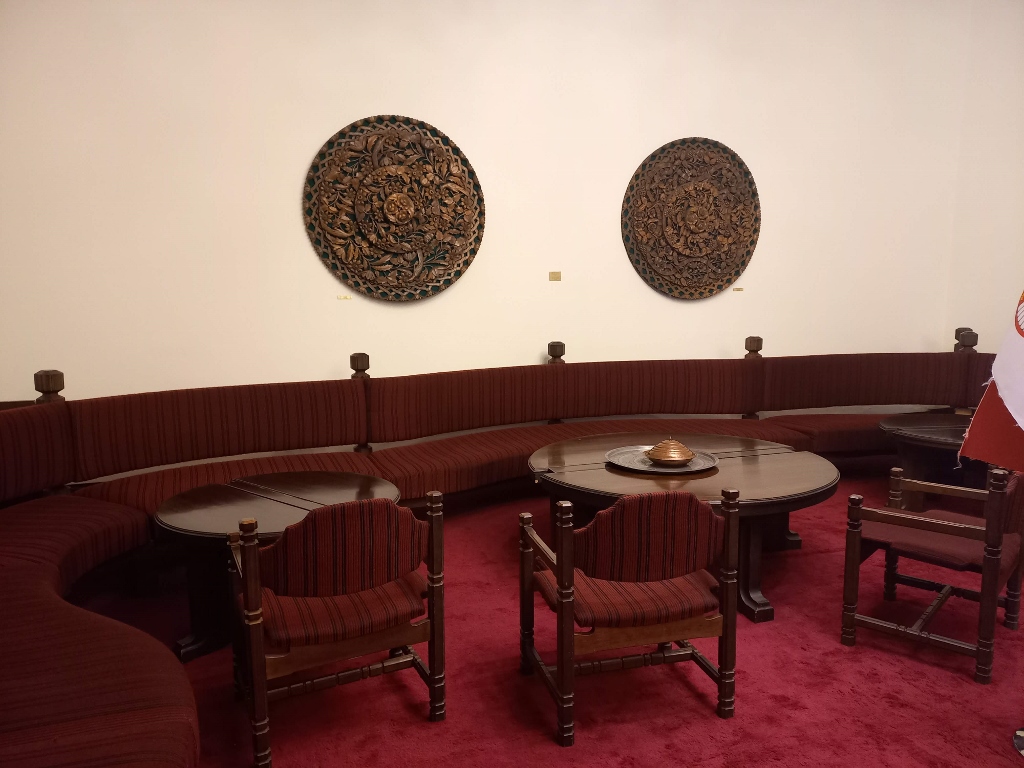 Palace of Serbia, Macedonian Salon, a detail
Palace of Serbia, Macedonian Salon, a detail
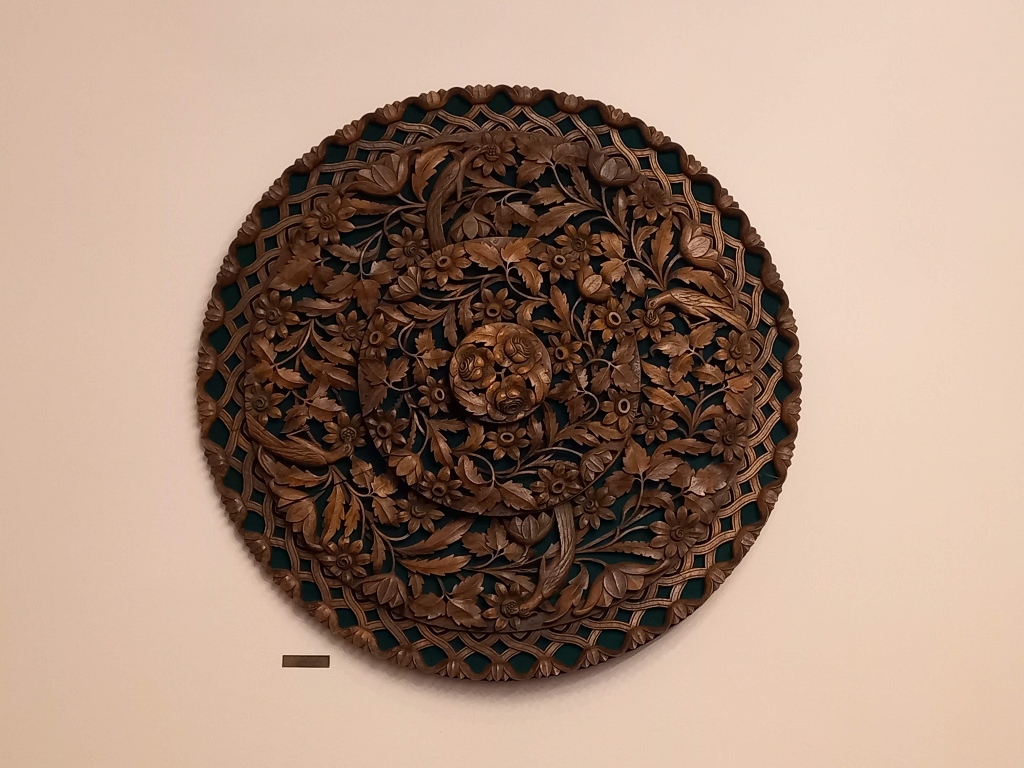 Palace of Serbia, Macedonian Salon, a detail
Palace of Serbia, Macedonian Salon, a detail
Next on the tour was the Montenegrin Salon.
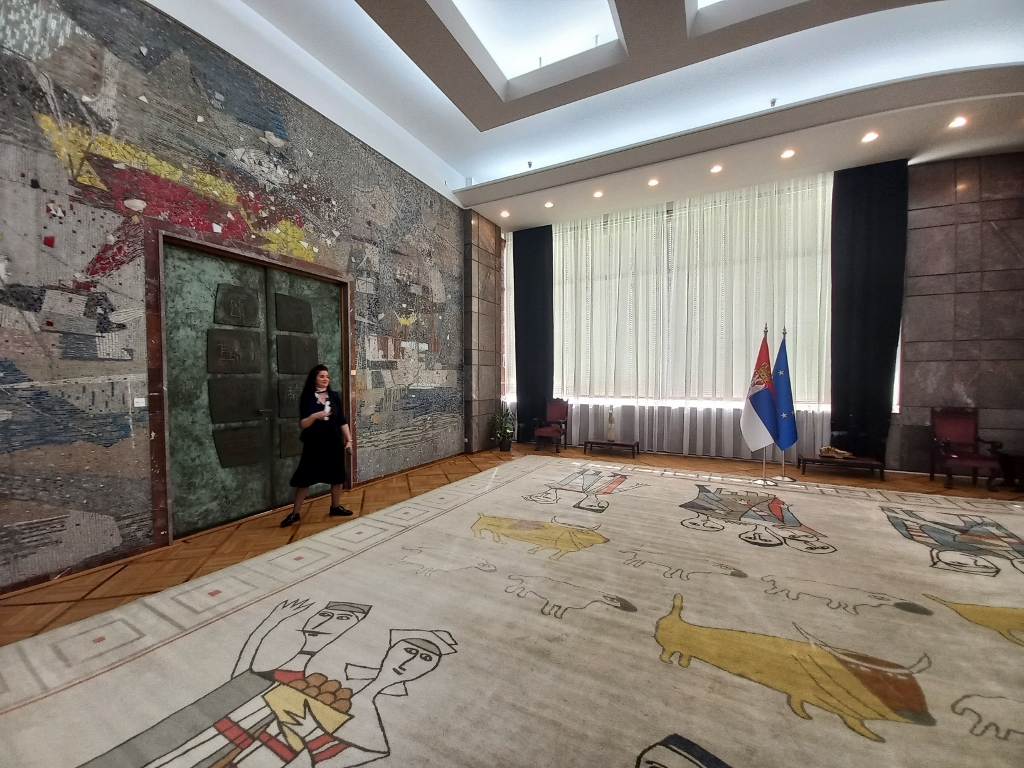 Palace of Serbia, Montenegrin Salon
Palace of Serbia, Montenegrin Salon
Here, too, an architect was in charge of the interior design and he drew inspiration from Montenegrin history from the first half of the 19th century, so some pieces of furniture were also crafted accordingly.
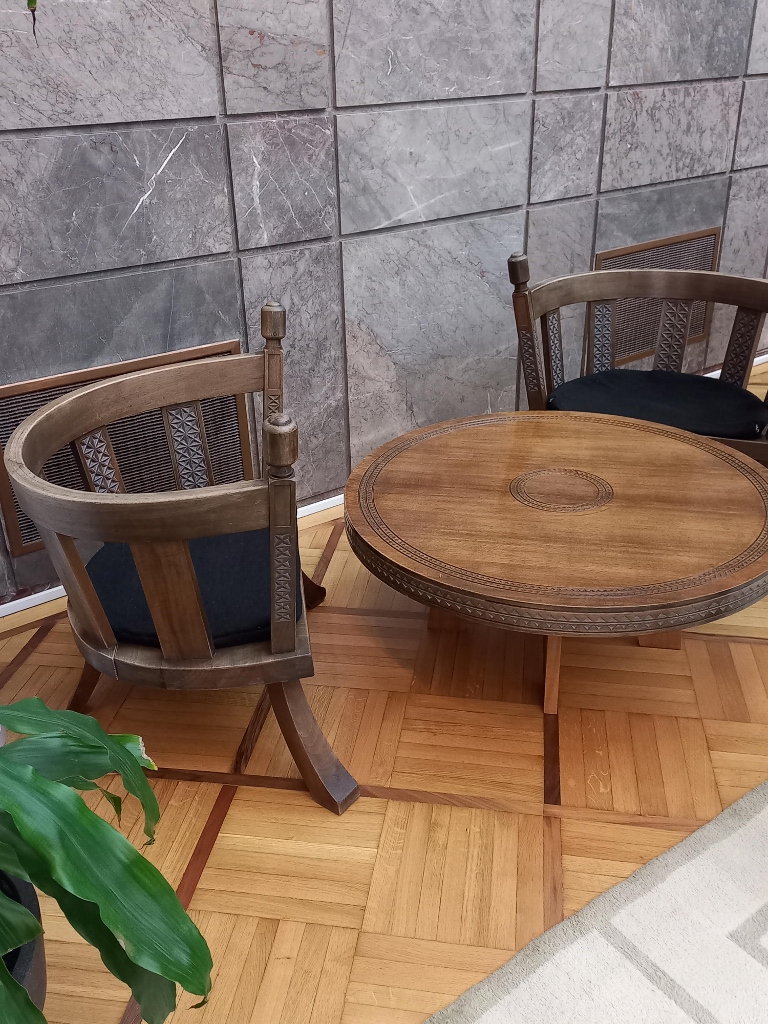 Palace of Serbia, Montenegrin Salon, a detail
Palace of Serbia, Montenegrin Salon, a detail
On the wall separating the Montenegrin Salon from the next one in line, the Slovenian Salon, there is a wall mosaic entitled “The Rebellion of Kotor Sailors and the Sinking of the Zagreb Ship,” dedicated to the events of 17 April, 1941, when two lieutenants of the Yugoslav Royal Navy sank the ship to prevent her from falling into the hands of the Italian army and both perished in the process. One of these lieutenants was Slovenian and the other was Serbian – just to mention for those who think that all members of the peoples within the territory of the former common state believed that Yugoslavia was a “prison of peoples.” On the doors leading to the next salon, there are also eight reliefs depicting motifs from Montenegrin history.
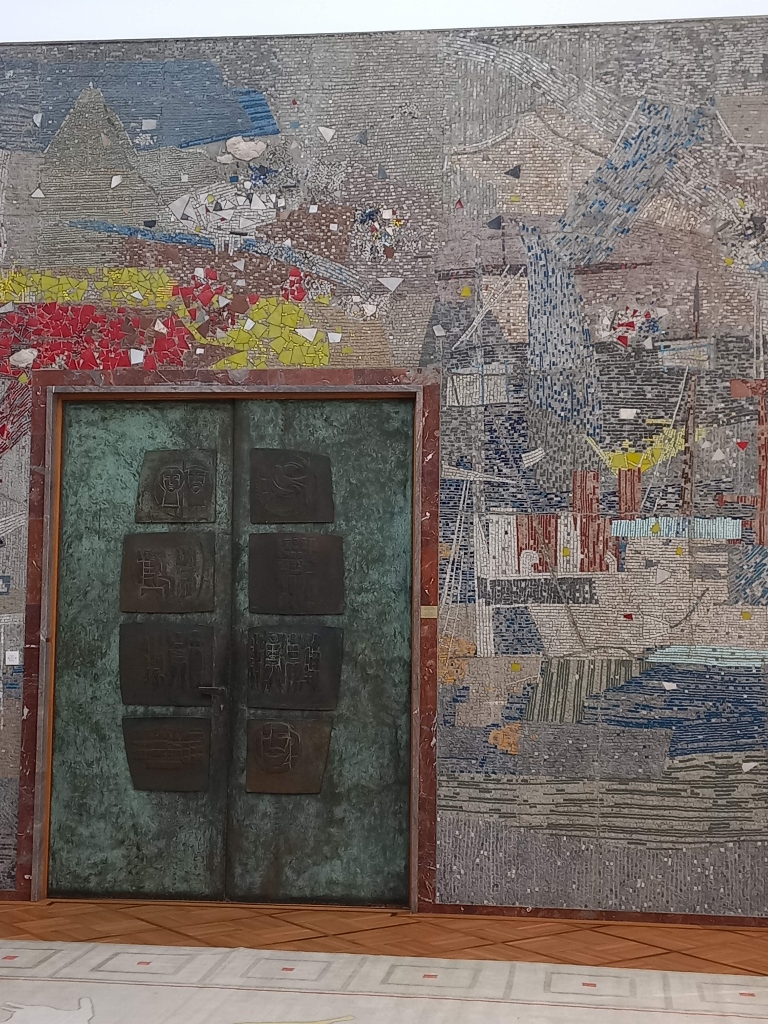 Palace of Serbia, Montenegrin Salon, a detail
Palace of Serbia, Montenegrin Salon, a detail
Through these doors, you enter the Slovenian Salon. The entire decoration throughout these salons, more or less noticeably, symbolises the republic to which the salon was dedicated and the design was carried out by architects from those republics. Thus, the chandeliers in this salon represent stalactites from the famous Postojna Cave.
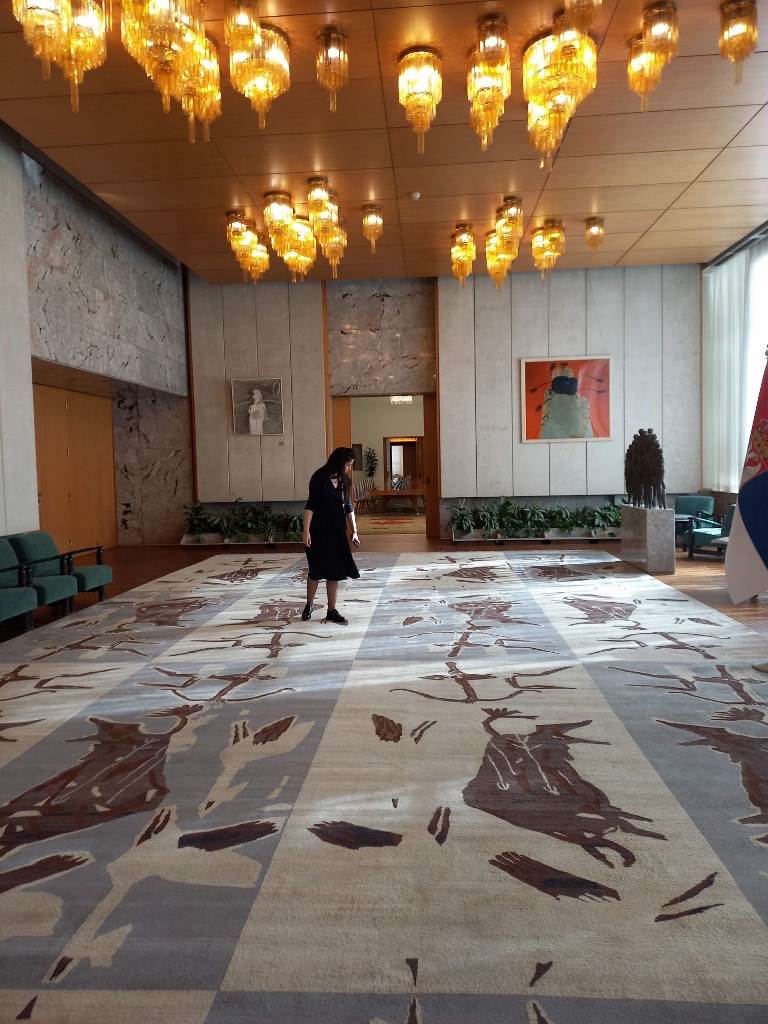 Palace of Serbia, Slovenian Salon
Palace of Serbia, Slovenian Salon
And the artworks are typically creations of artists from the respective republics.
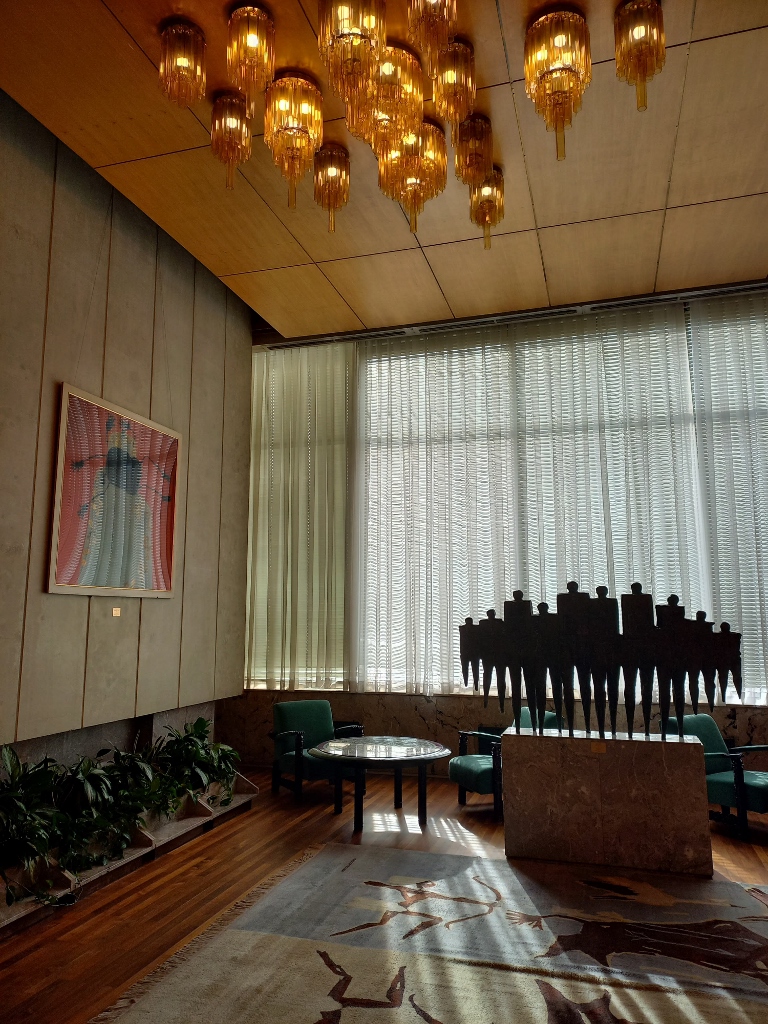 Palace of Serbia, Slovenian Salon, a detail
Palace of Serbia, Slovenian Salon, a detail
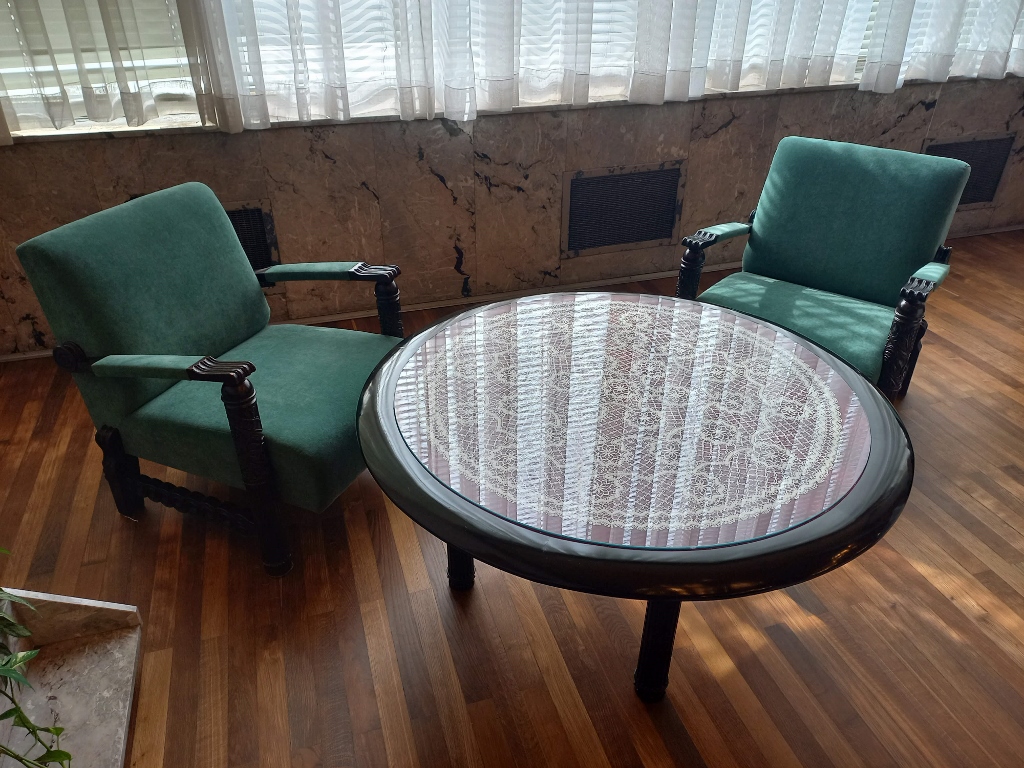 Palace of Serbia, Slovenian Salon, a detail
Palace of Serbia, Slovenian Salon, a detail
Next, we moved into the Serbian Salon, the carpets in which were inspired by the paintings of Lazar Vujaklija (1914-1996), a renowned Serbian artist whose works are abundant with traditional motifs.
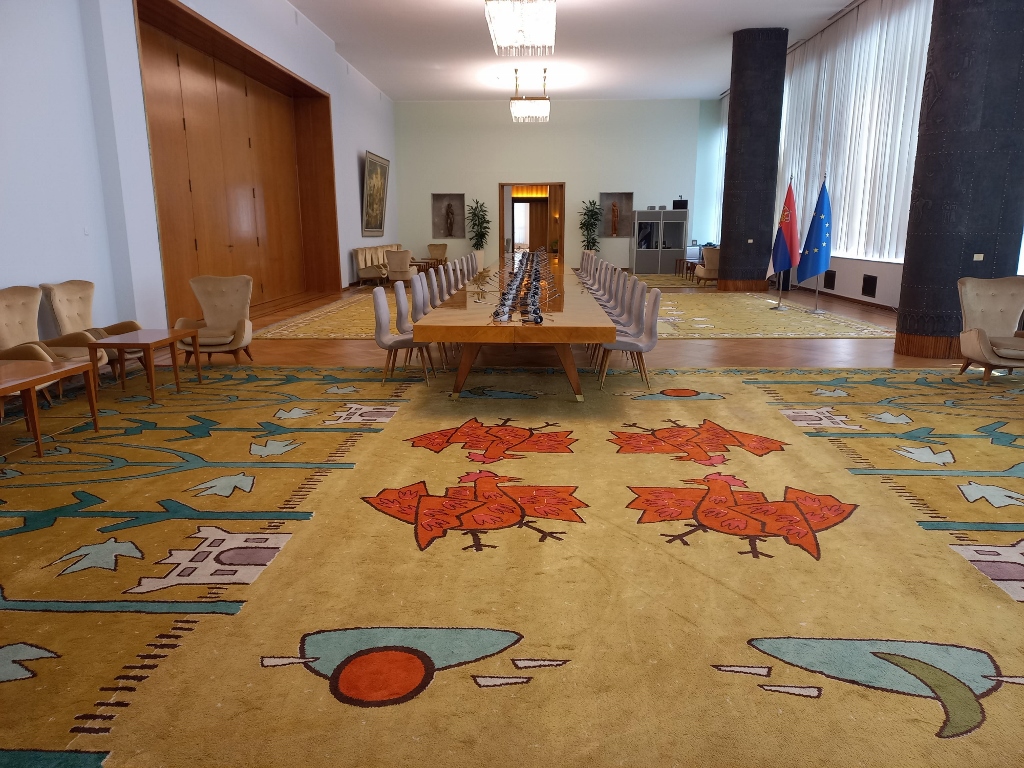 Palace of Serbia, Serbian Salon
Palace of Serbia, Serbian Salon
This is the second-largest salon and the decoration even includes columns covered in bronze depicting motifs from Serbian history from the 1840s.
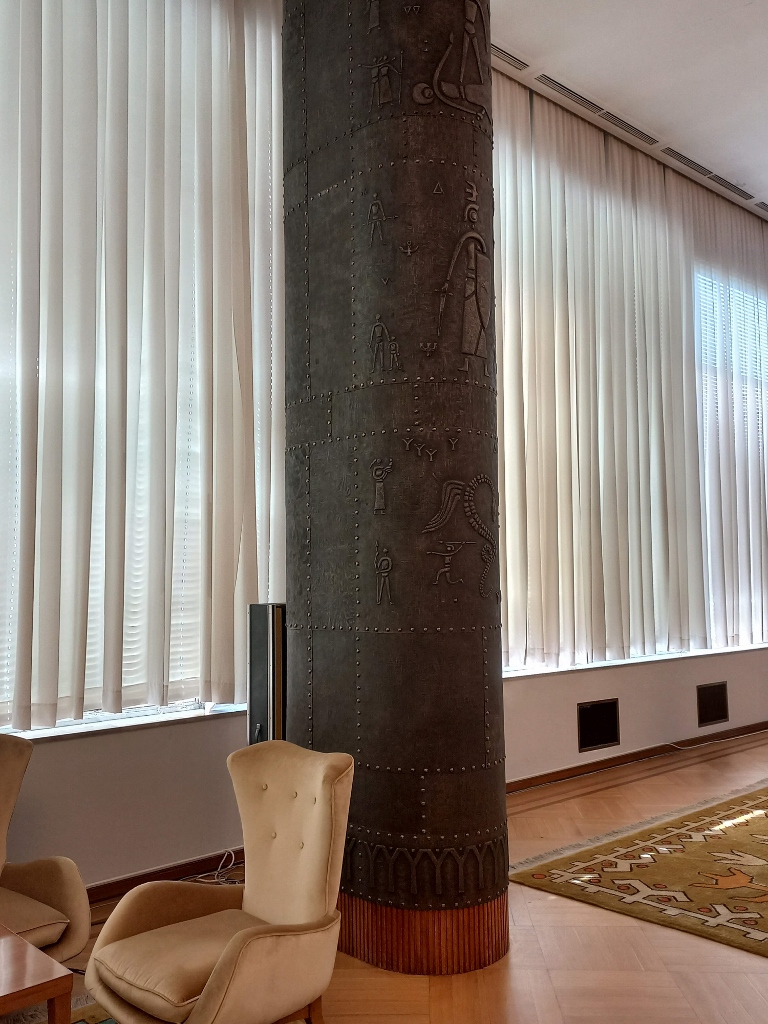 Palace of Serbia, Serbian Salon, a detail
Palace of Serbia, Serbian Salon, a detail
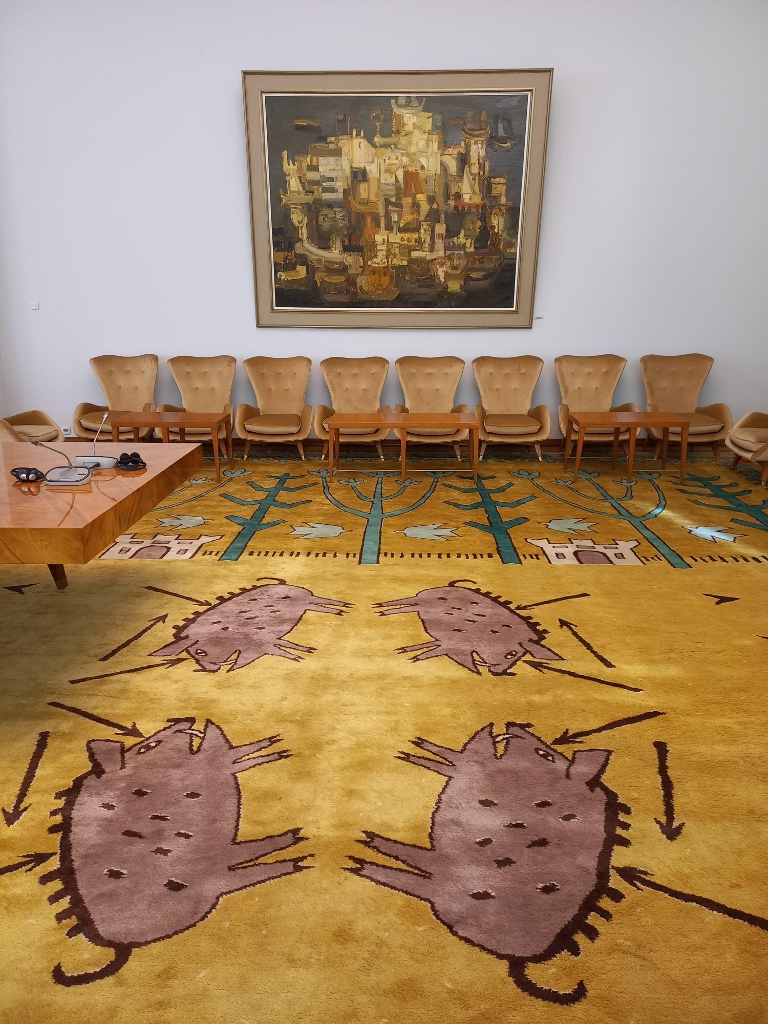 Palace of Serbia, Serbian Salon, a detail
Palace of Serbia, Serbian Salon, a detail
The next one is the Bosnia and Herzegovina Salon.
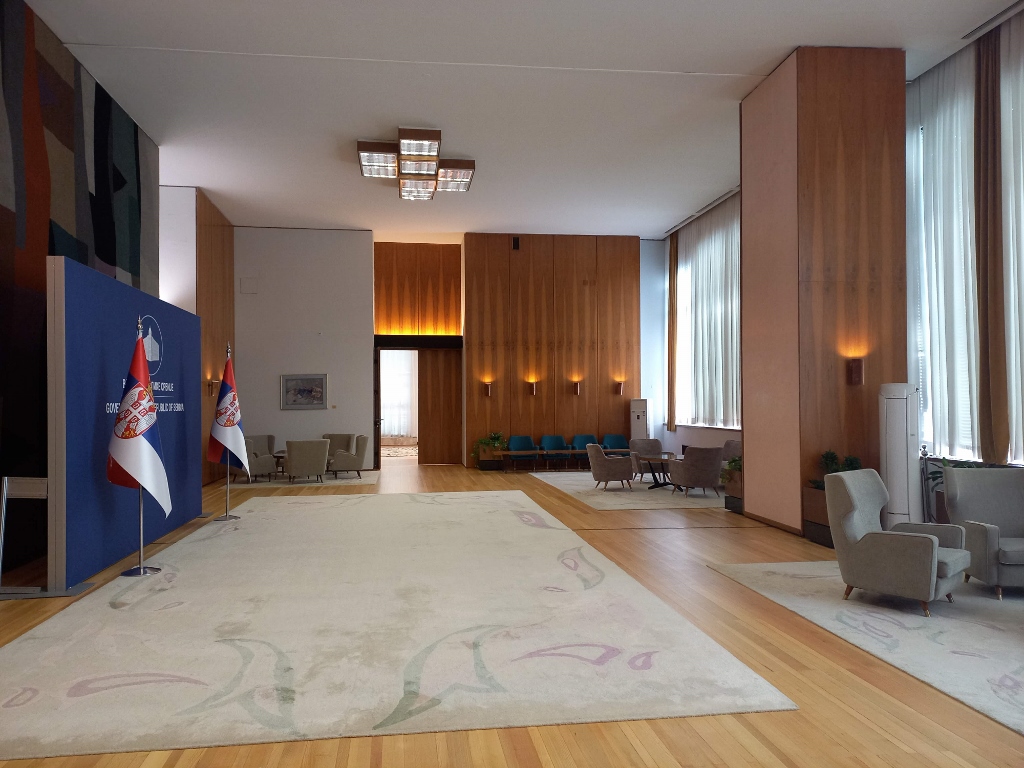 Palace of Serbia, Bosnia and Herzegovina Salon
Palace of Serbia, Bosnia and Herzegovina Salon
The salon was originally decorated in a style reflecting the republic of Bosnia and Herzegovina, with the centrepiece being a tapestry named “Forest” made at a carpet factory in Sarajevo. Today, this tapestry can still be seen, albeit partially, as it is obscured by a panel in front of which press conferences are often held. Over time, the salon has changed its function, resulting in some details being altered.
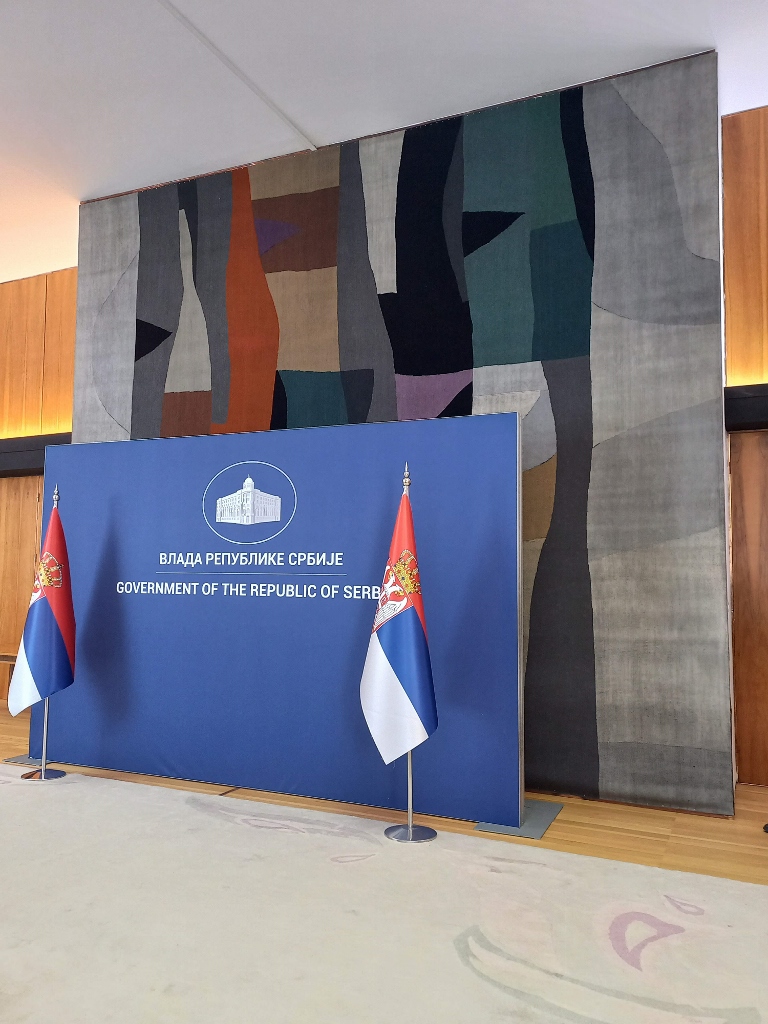 Palace of Serbia, Bosnia and Herzegovina Salon, a detail
Palace of Serbia, Bosnia and Herzegovina Salon, a detail
From here, one can move on to the Croatian Salon or the East Foyer.
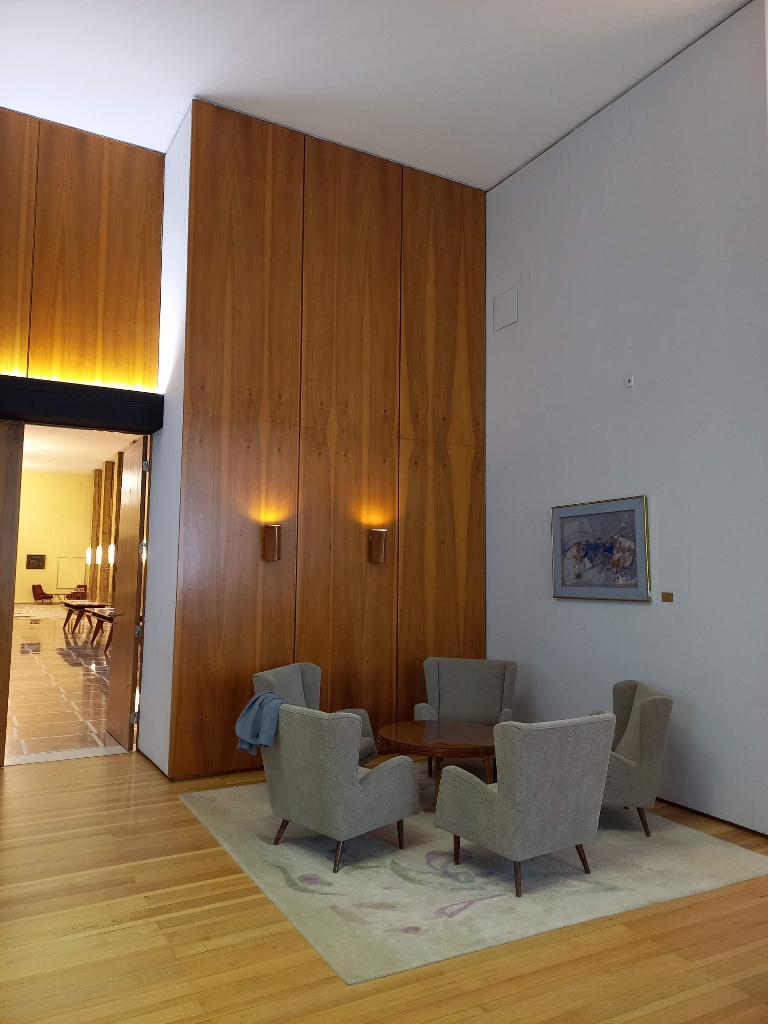 Palace of Serbia, Bosnia and Herzegovina Salon, you can see the East Foyer to the left
Palace of Serbia, Bosnia and Herzegovina Salon, you can see the East Foyer to the left
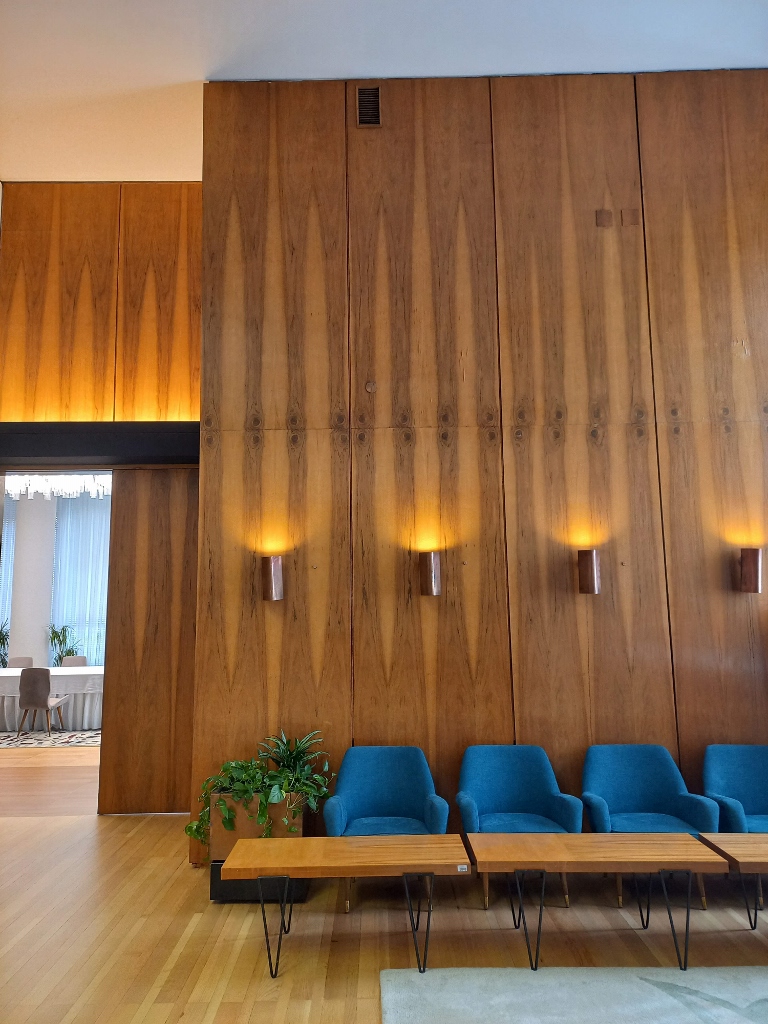 Palace of Serbia, Bosnia and Herzegovina Salon, you can see the Croatian Hall to the left
Palace of Serbia, Bosnia and Herzegovina Salon, you can see the Croatian Hall to the left
We first entered the Croatian Salon, which, in my experience, is often used for lunches today (it's the one closest to the kitchen). That’s why I didn’t want to take a photo of the long table, although it can be glimpsed in the previous photograph.
What adorns this salon is a huge fresco that stretches along the entire wall of the salon, and a part of it can be seen in the next picture.
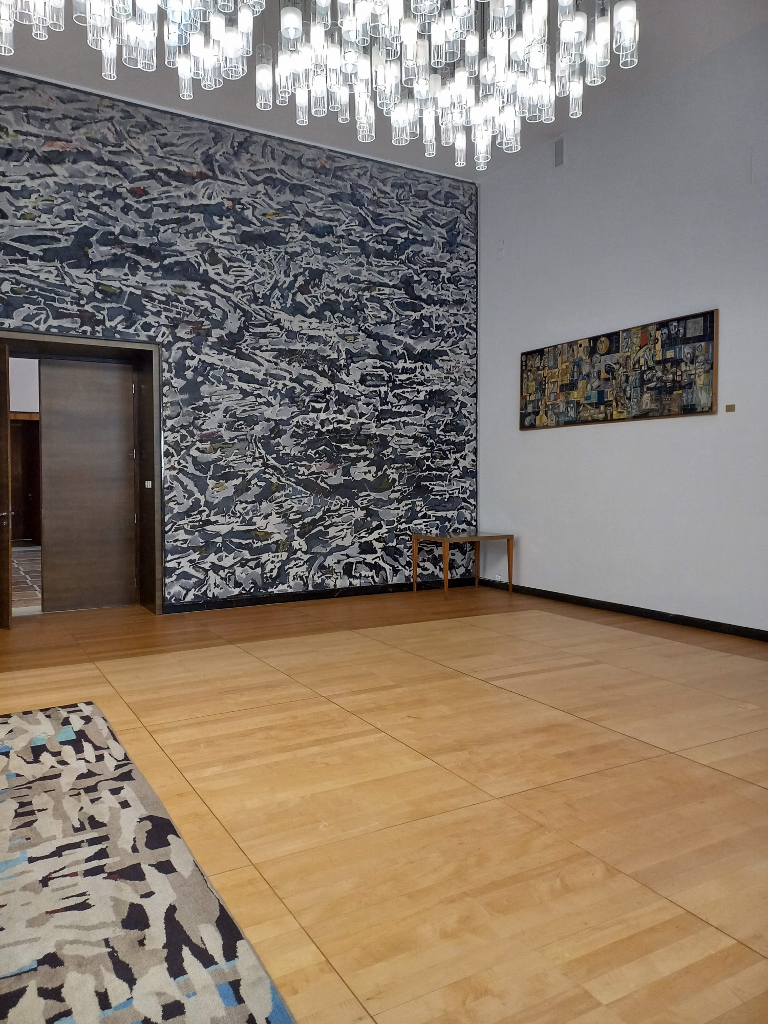 Palace of Serbia, Croatian Salon
Palace of Serbia, Croatian Salon
Here, one can see a chandelier that extends the entire length of the salon and that is an important decorative element. There are also several artworks, including a tapestry created by the famous Croatian artist Jagoda Buić (1930-2022).
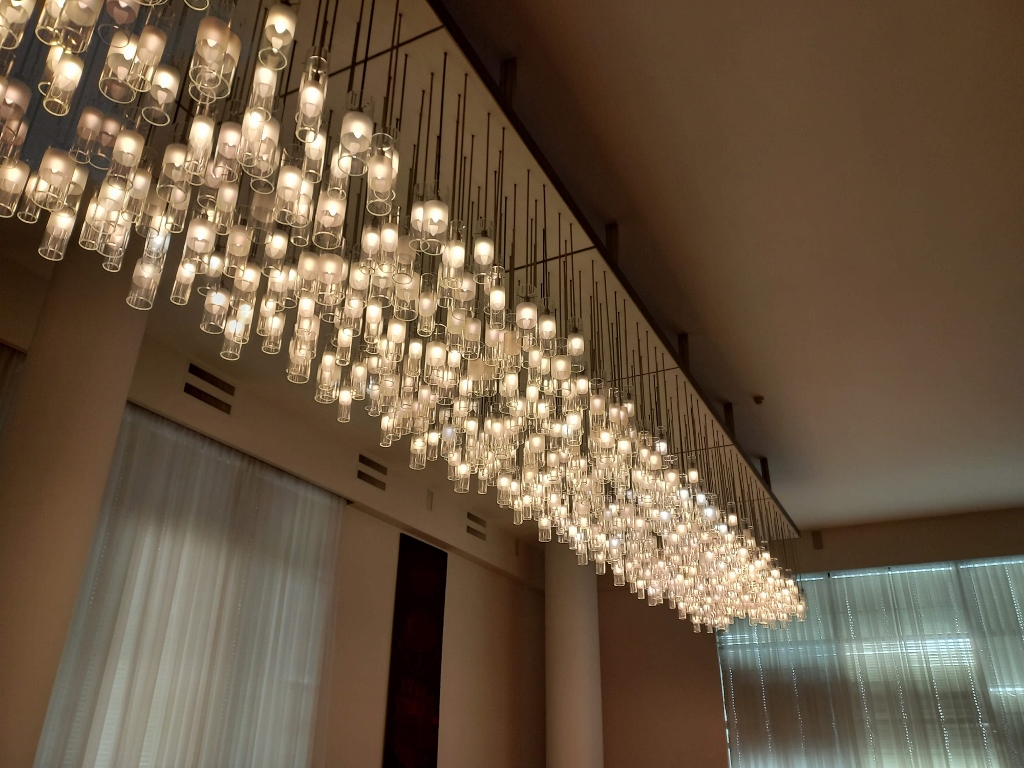 Palace of Serbia, Croatian Salon, a detail
Palace of Serbia, Croatian Salon, a detail
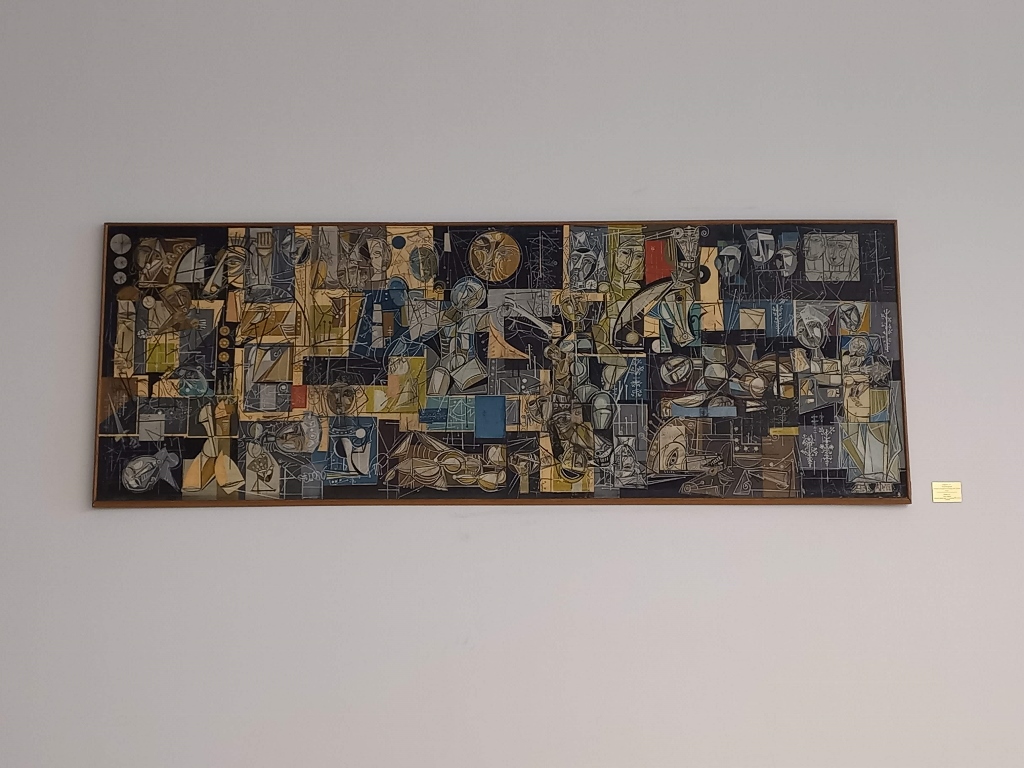 Palace of Serbia, Croatian Salon, a detail
Palace of Serbia, Croatian Salon, a detail
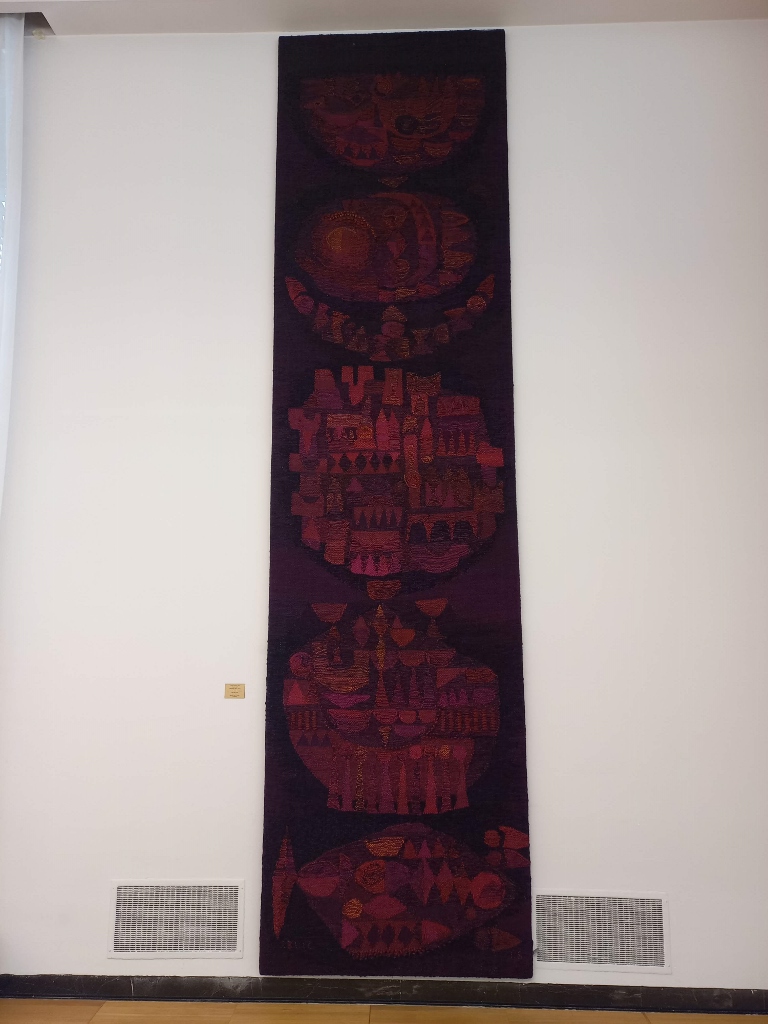 Palace of Serbia, Croatian Salon, a detail
Palace of Serbia, Croatian Salon, a detail
From here, we moved to the East Foyer, where one wall is adorned with four large tapestries (3 x 2.3 m).
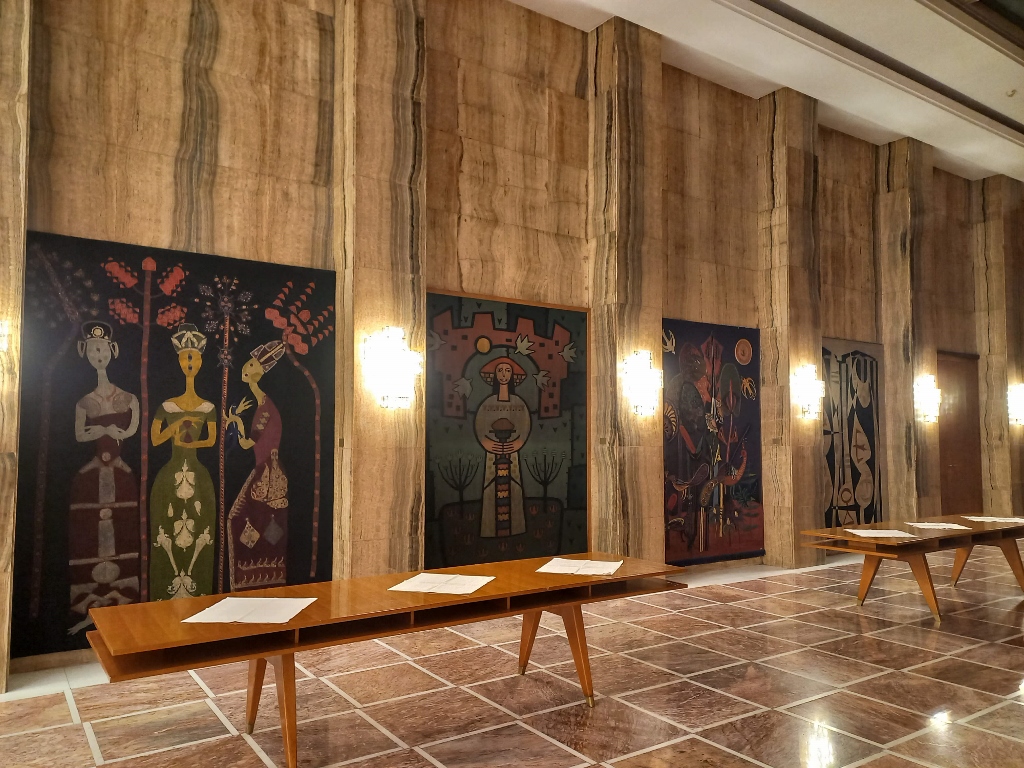 Palace of Serbia, East Foyer
Palace of Serbia, East Foyer
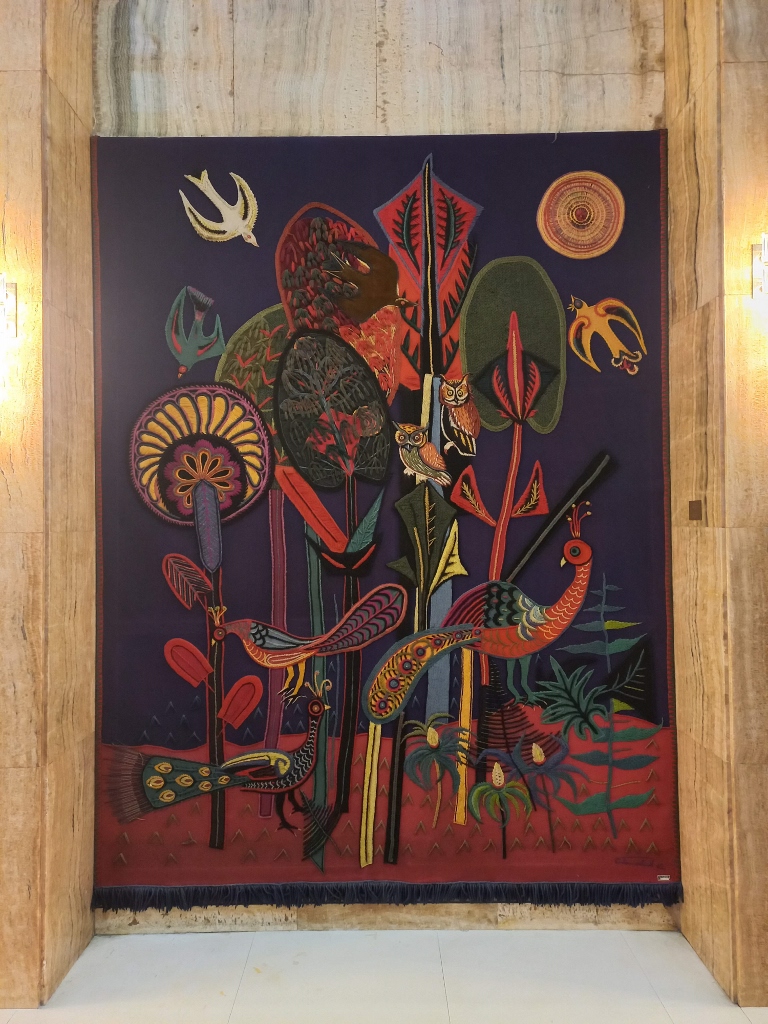 Palace of Serbia, East Foyer, a detail
Palace of Serbia, East Foyer, a detail
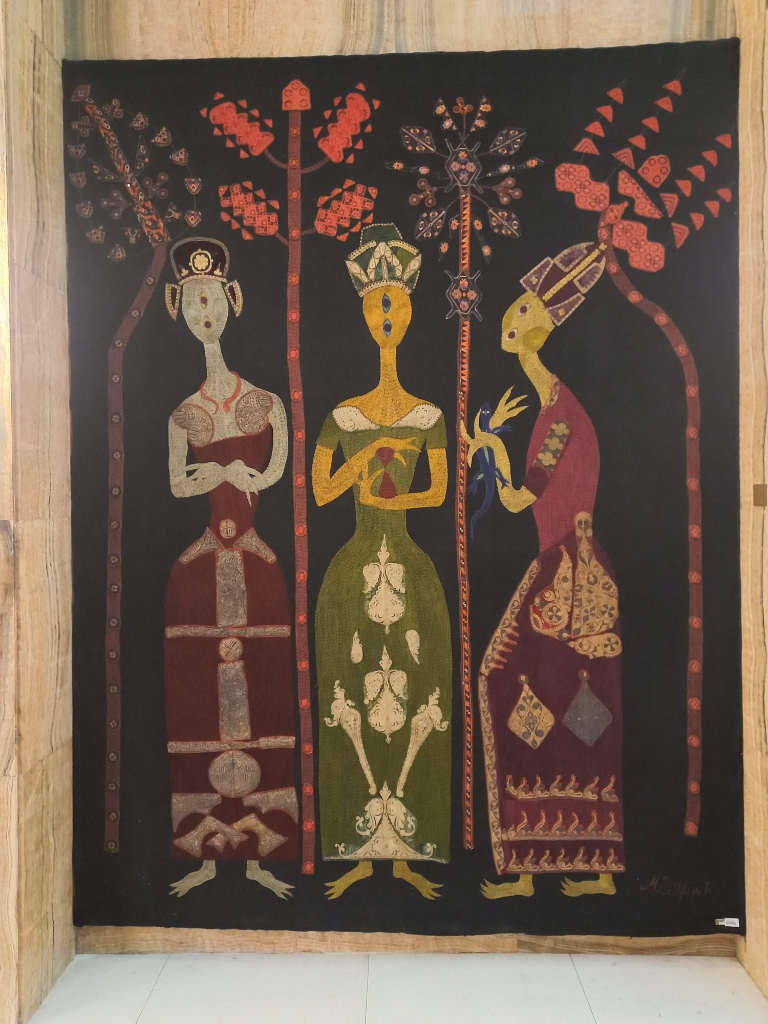 Palace of Serbia, East Foyer, a detail
Palace of Serbia, East Foyer, a detail
On the opposite wall, there are four pieces by the renowned Serbian painter Đorđe Andrejević-Kun (1904-1964).
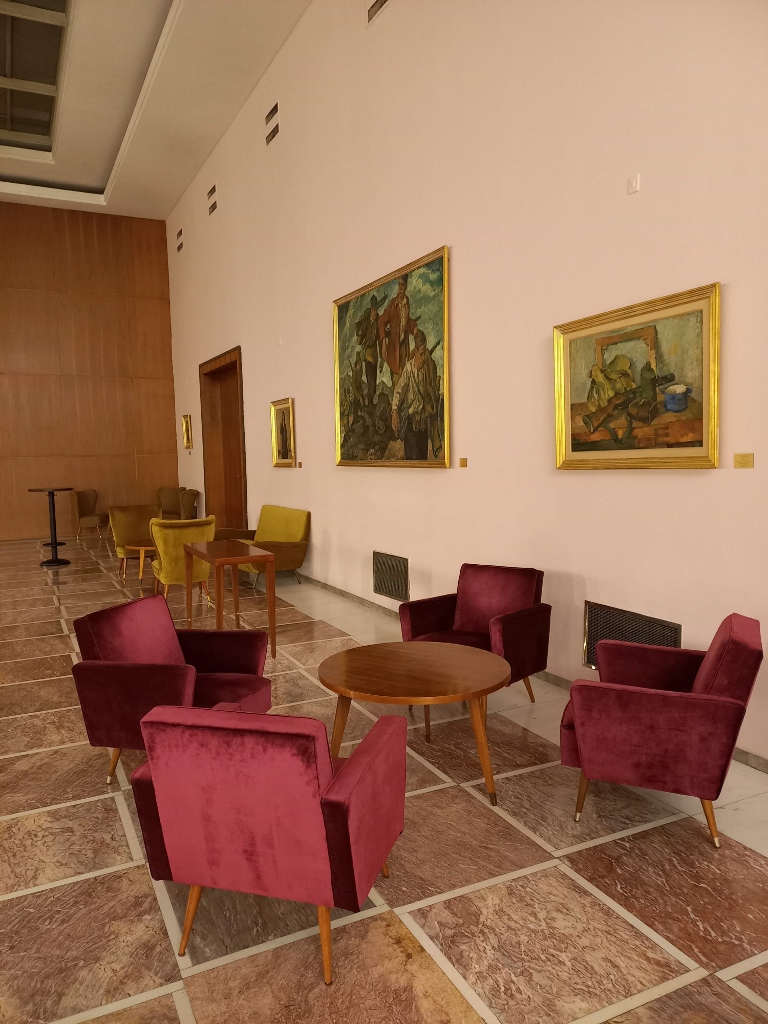 Palace of Serbia, East Foyer
Palace of Serbia, East Foyer
Đorđe Andrejević-Kun was a participant in the Spanish Civil War and the People’s Liberation Struggle, which is the term for the Yugoslav peoples’ participation in WWII led by the Communist Party of Yugoslavia, so his themes are in line with that experience. It’s also interesting to note that he is the author of the coat of arms of the City of Belgrade that is still in use today.
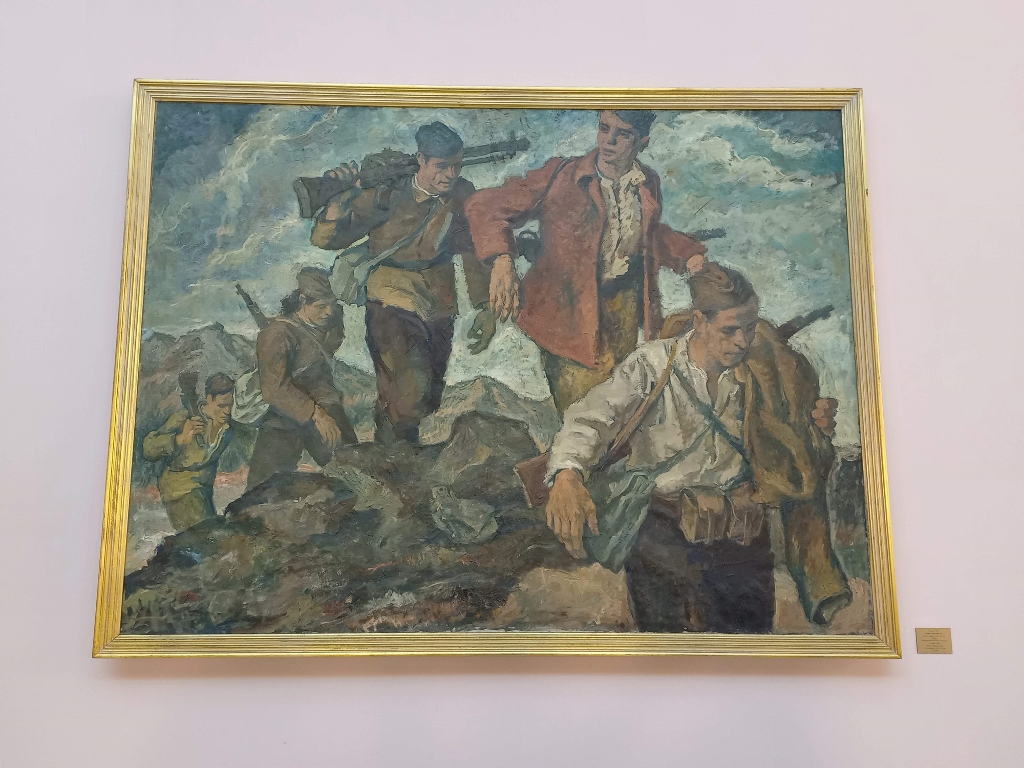 Column, by Đorđe Andrejević-Kun
Column, by Đorđe Andrejević-Kun
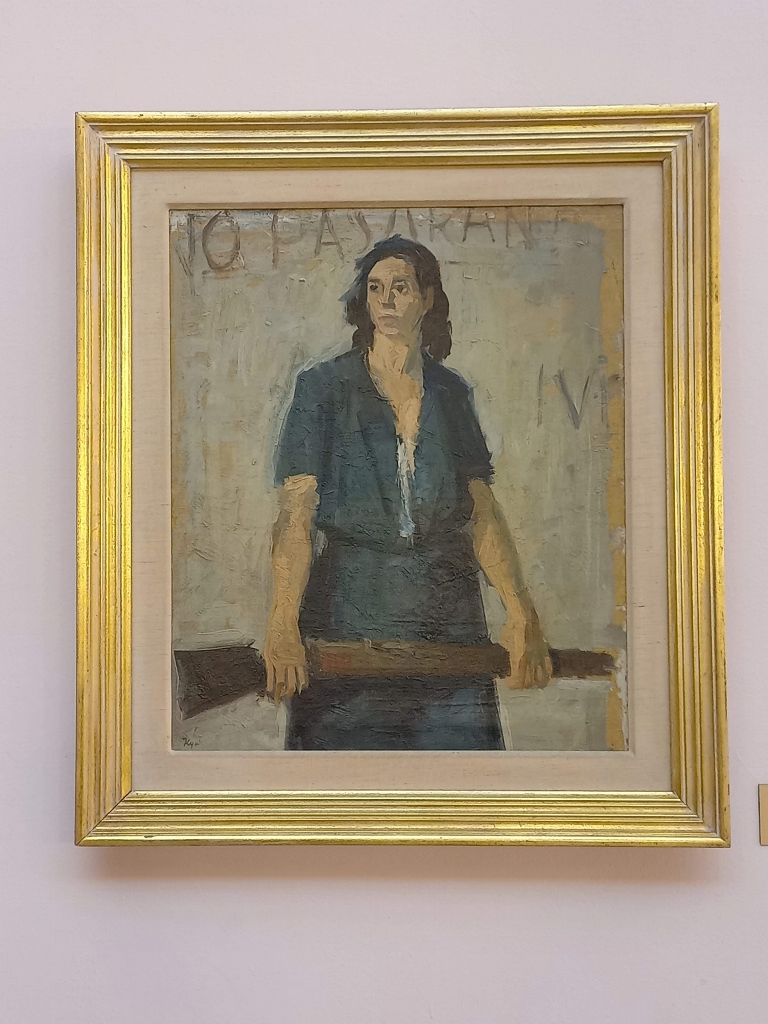 No pasaran, by Đorđe Andrejević-Kun
No pasaran, by Đorđe Andrejević-Kun
The East Foyer extends to the side entrance of the Belgrade Salon that is often used for roundtable meetings (tables are connected and literally form a circle).
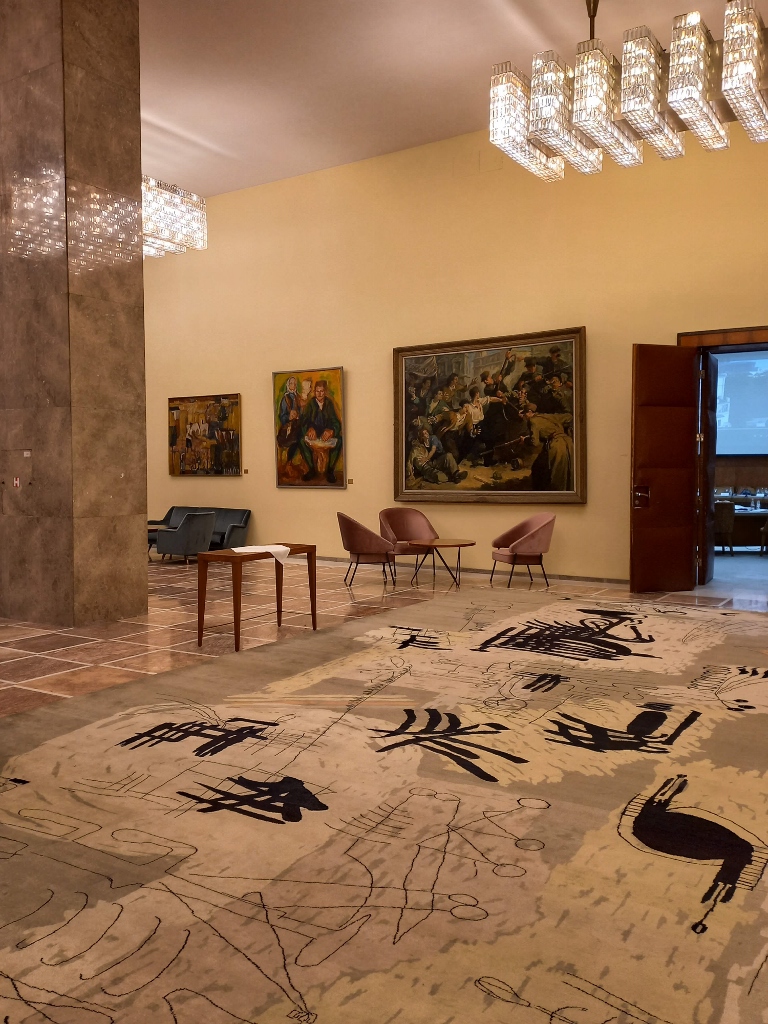 Palace of Serbia, East Foyer, with the door leading to the Belgrade Salon to the right
Palace of Serbia, East Foyer, with the door leading to the Belgrade Salon to the right
All these salons I have talked about are actually arranged around a spacious central hall located behind the wall with “The Sutjeska” mosaic that I've already mentioned. This is the largest and most representative room in the palace, aptly named the Yugoslavia Hall. The hall has an area of 800 square metres and can accommodate around 2000 guests.
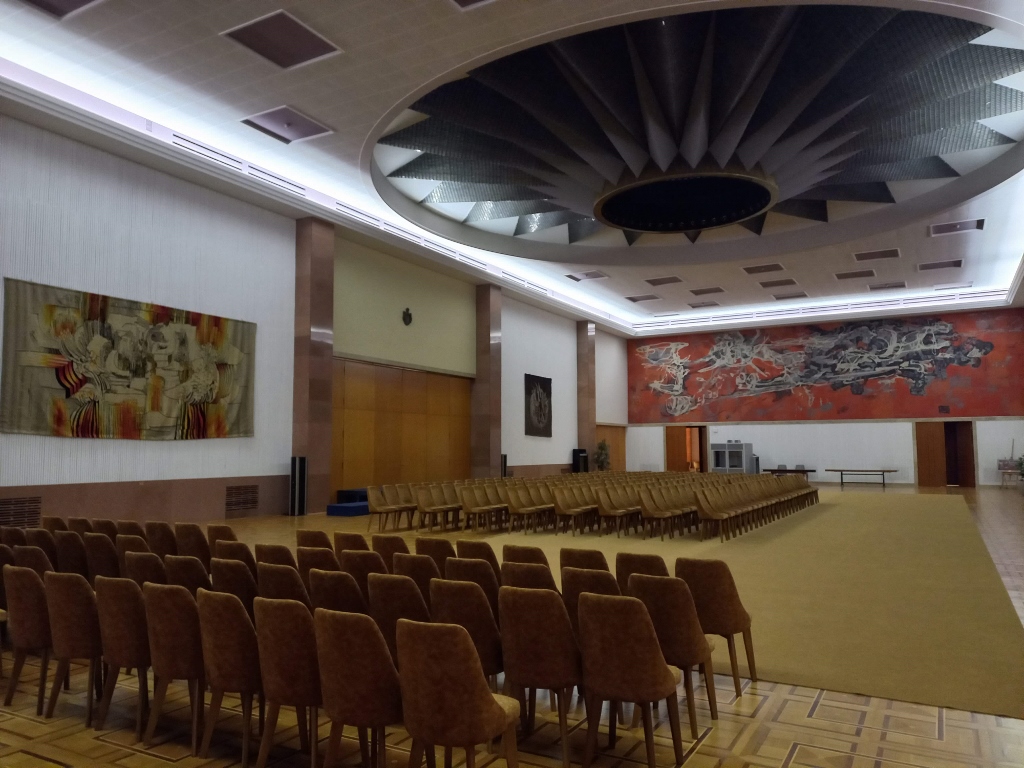 Palace of Serbia, Yugoslavia Hall
Palace of Serbia, Yugoslavia Hall
The arrangement of chairs and massive tables depends on the events organised here, but on this occasion the hall was very quiet and completely empty, except for us visitors who walked through it.
The hall is adorned with several large artworks, including three wall compositions. One of them is the fresco “Flight into the Cosmos” by the famous Serbian painter Petar Lubarda.
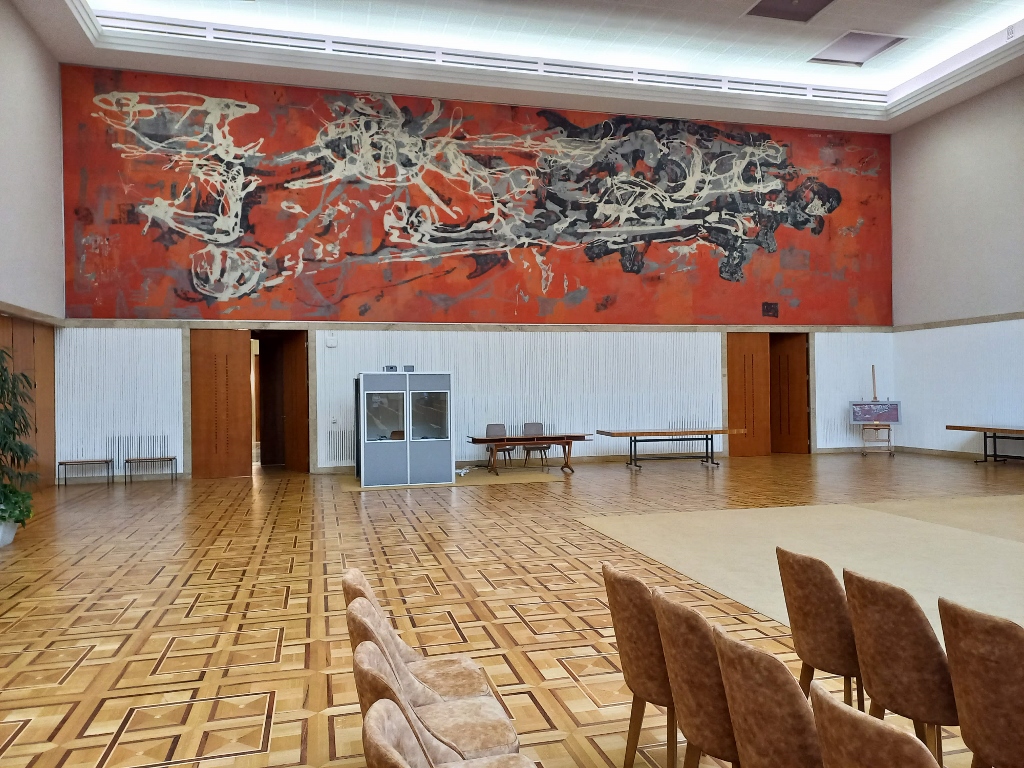 Palace of Serbia, Yugoslavia Hall, a detail
Palace of Serbia, Yugoslavia Hall, a detail
Then there is a mosaic triptych “The Creation of a New Yugoslavia,” by Mladen Srbinović, which I captured in two photographs.
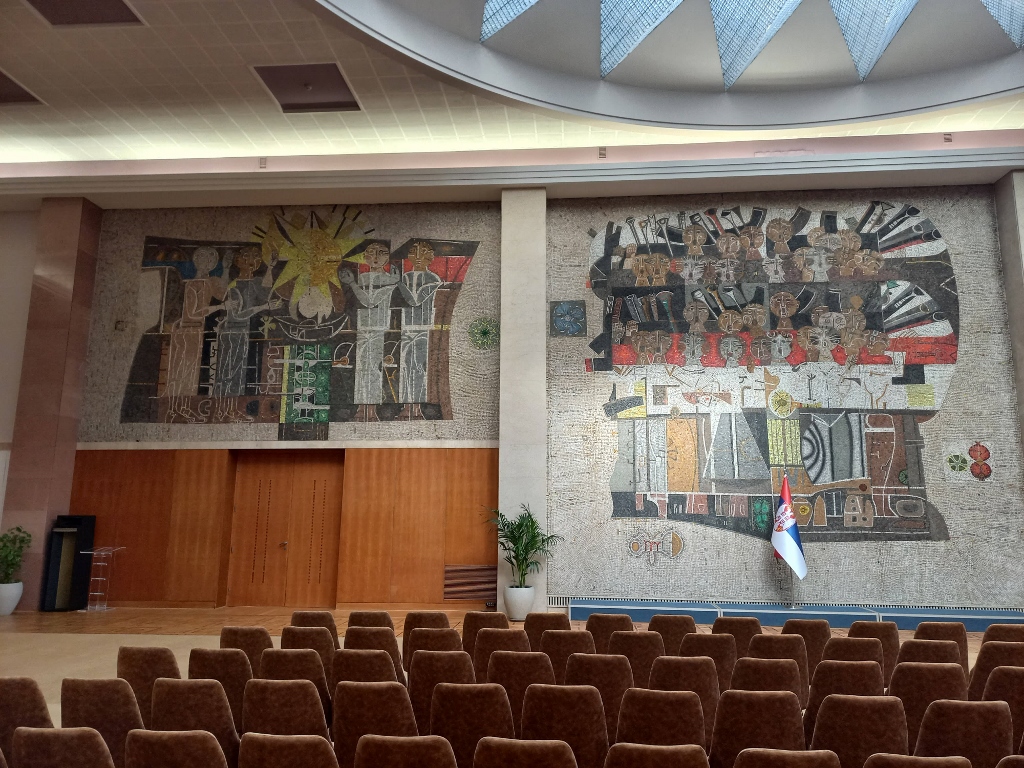 Palace of Serbia, Yugoslavia Hall, a detail
Palace of Serbia, Yugoslavia Hall, a detail
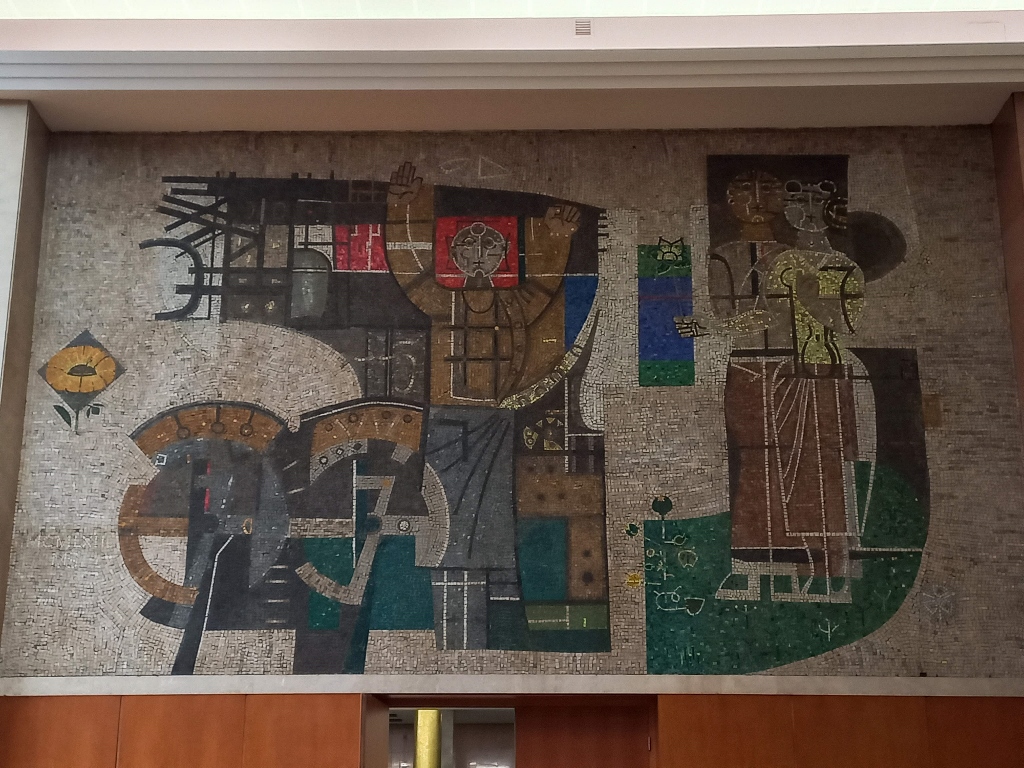 Palace of Serbia, Yugoslavia Hall, a detail
Palace of Serbia, Yugoslavia Hall, a detail
And there is also the fresco "Roads of the New Yugoslavia,” by the previously mentioned Lazar Vujaklija.
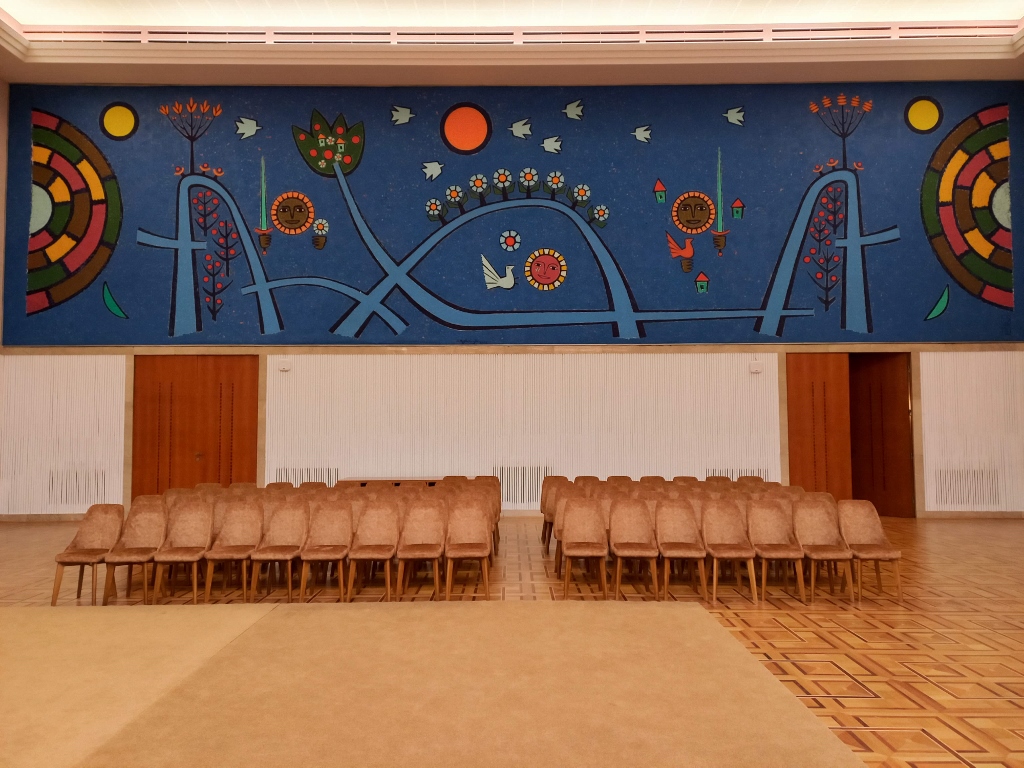 Palace of Serbia, Yugoslavia Hall, a detail
Palace of Serbia, Yugoslavia Hall, a detail
One of the striking decorative elements is the impressive rosette-shaped chandelier with steel arms located under the dome that provides a large amount of natural light. Of course, this isn’t enough, so there are also around 2600 light bulbs.
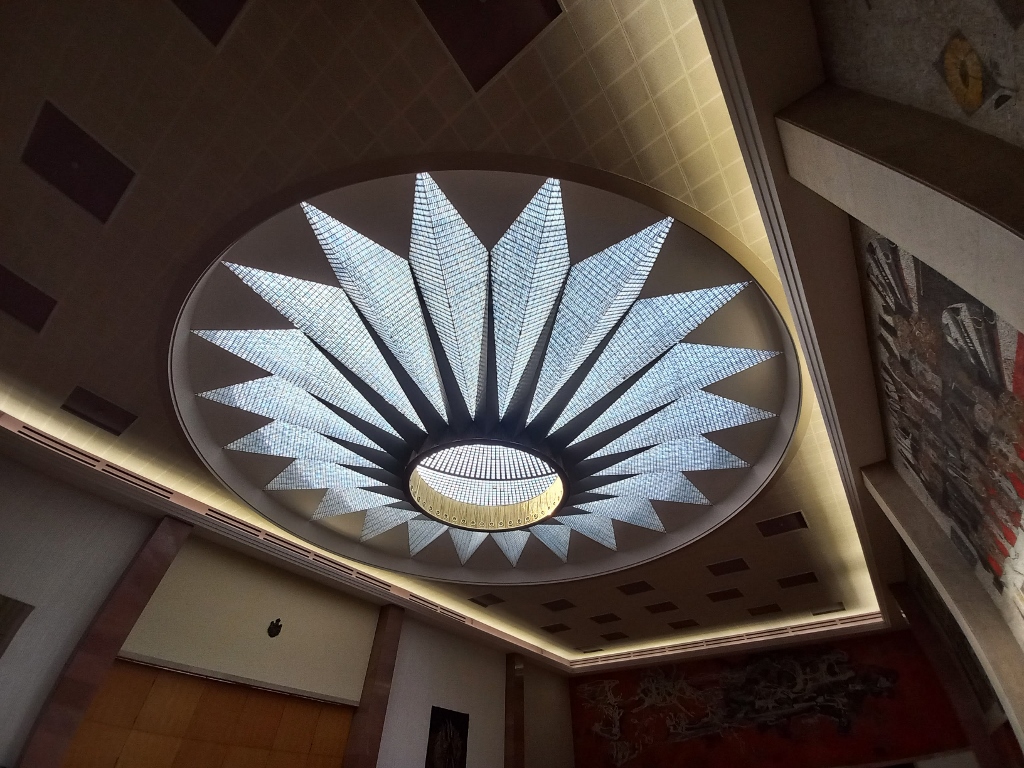 Palace of Serbia, Yugoslavia Hall, a detail
Palace of Serbia, Yugoslavia Hall, a detail
The chandelier has a diameter of 18 meters and weighs nine tons! At the time when the Palace of Serbia was built, this was the largest chandelier in the world.
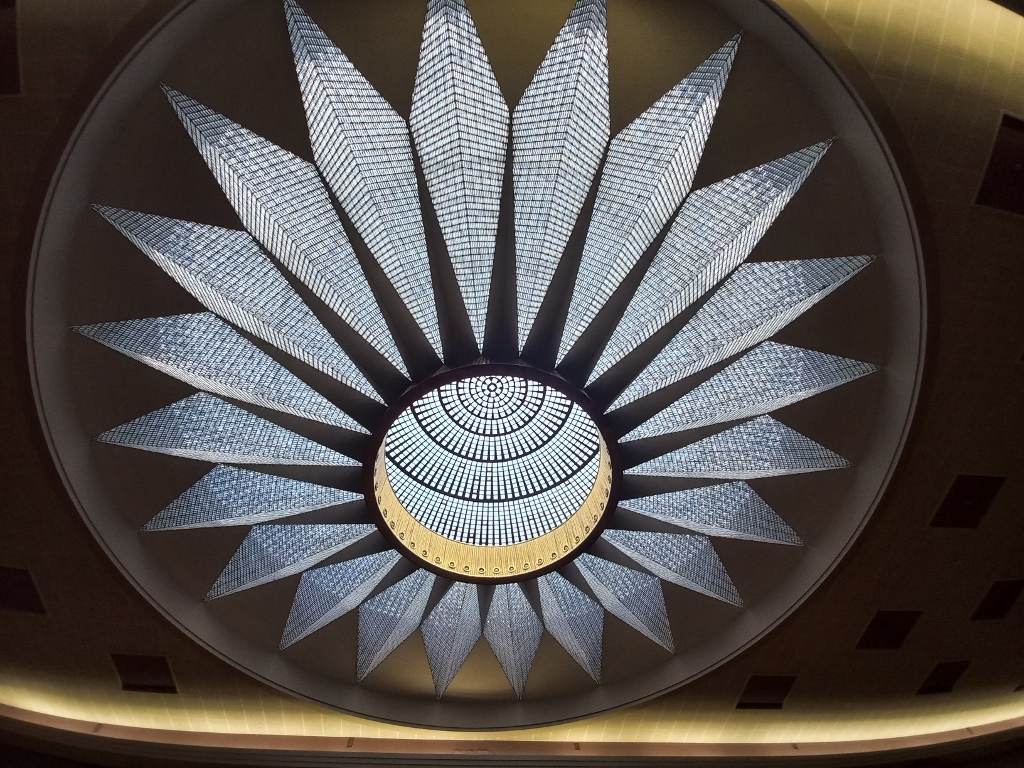 Palace of Serbia, Yugoslavia Hall, a detail
Palace of Serbia, Yugoslavia Hall, a detail
Here, the planned tour of the representative part of the Palace of Serbia ended, so we all returned to the Belgrade Salon where the meeting I was interpreting at with my colleague Beka was held.
In addition to what can be seen in my photographs, as I’ve mentioned, all these salons and foyers are adorned with numerous artworks. However, they can also be seen in other parts of the building, such as a corridor I later walked through.
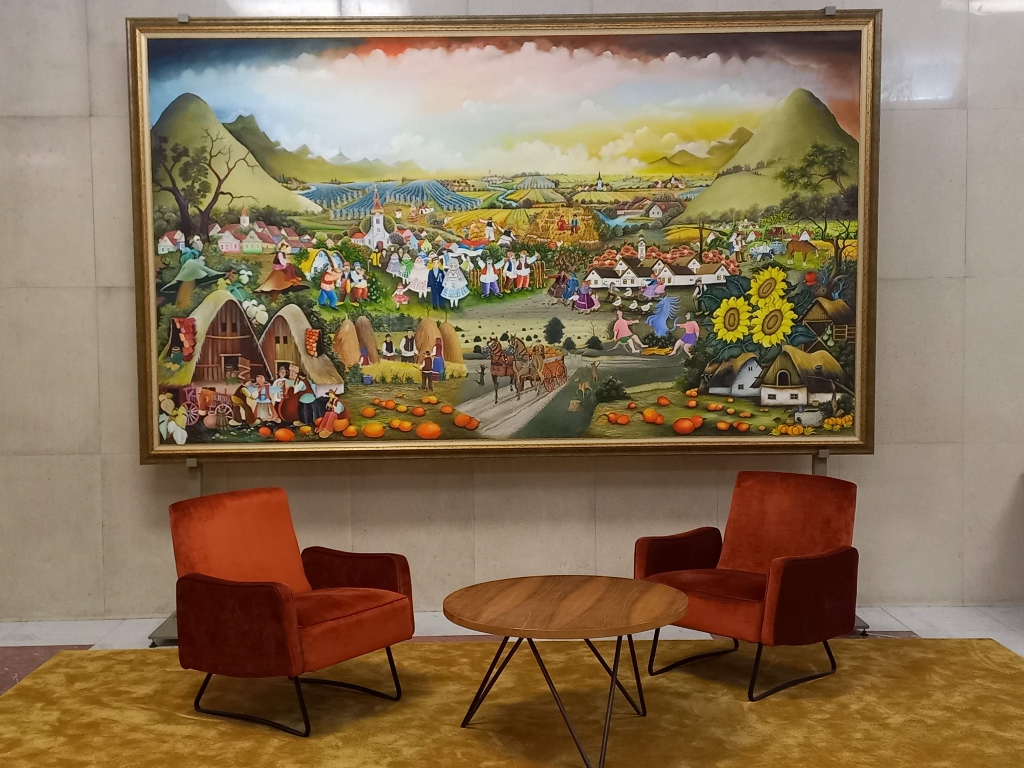 Palace of Serbia, a detail
Palace of Serbia, a detail
At the end of the day, I walked around the back of the Palace of Serbia.
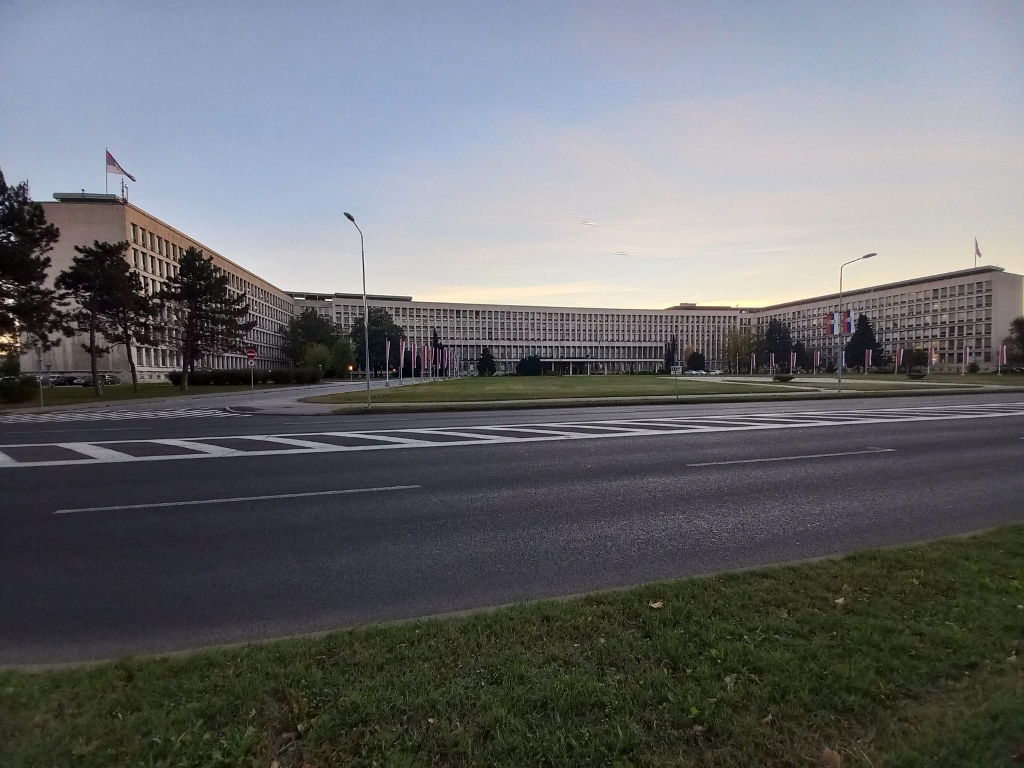 Back side of the Palace of Serbia at dusk
Back side of the Palace of Serbia at dusk
By the way, adjacent to the Palace of Serbia there are green spaces, essentially park areas that are part of the entire complex, as well as parking lots for employees and visitors.
However, I took the previous photo from a large park that extends along the Danube, which is itself a rather beautiful and interesting place in Novi Beograd. I’ll talk more about that next time.
And here is what will be mentioned and seen in my story about Novi Beograd or New Belgrade: